#Virtual Networking Explained
Text
ZeroTier Download and Install: Connect Devices Together from Anywhere
ZeroTier Download and Install: Connect Devices Together from Anywhere #Zerotier #DecentralizedNetwork #SecureMobileDevice #ZerotierVsTraditionalVPNs #SoftwareDefinedNetworking #AdvancedZerotierFeatures #homelab #selfhosted #connectdevicestogether
Networking is often one of the most challenging aspects of connecting devices and using applications. It is also extremely important to consider when self-hosting services or connecting devices together that may be connecting to many different networks across the Internet. Let’s look at Zerotier download and installation to see how it can easily connect multiple devices to the same virtual…

View On WordPress
#Advanced Zerotier Features#Decentralized Network Creation#Global Digital Connectivity Solutions#Network Management Simplified#Secure Mobile Device Integration#Software-Defined Networking Revolution#Virtual Networking Explained#Zerotier Commercial Packages#Zerotier Comprehensive Guide#Zerotier vs Traditional VPNs
0 notes
Note
Hey, can I ask for the teachers to meet their son (male!reader, that isn't Yuu) boyfriend ? Like, what is the boy they accepted and who they don't ? (And if you write for Yuu, can you add them pls ?)
Ignore it if you don't want to write it !!
♡︎Gender Neutral Terms as always!
♡︎I have turned this into a Rank, help?
♡︎Includes: NRC(No Ortho), RSA and Rollo

⋆⋅☆You are more than free to date them, the teachers fully approve of them
I’m having a hard time picking the first place. So I’m simply going to place these two here.
1. Kalim and Silver!
Do I even need to explain why? They are the greenest flags ever, they would be so sappy and cute and always treat you well and the teachers are fully aware of that, they can see that they truly care for you.
2. Neige
I didn’t place Neige with Kalim and Silver because he is from another school, the teachers would be sceptical of this far-away dating but would still fully approve of it, after all, Neige is extremely kind and considerate of you.
3. Trey
Of course, he is here, Trey would be a great boyfriend, male wife material, like c’mon he can cook and he knows how to take care of little kids, the teachers would completely approve of you dating him.
4. Jack
Jack is the sweetest boy ever, and there is no way the teachers would ever be against him being your boyfriend. He is ranked a bit lower than the others because the teachers find him a little too shy when it comes to showing affection. They believe you deserve someone who isn't afraid to be open about their love with you. Not that you mind that much.
5. Epel
The teachers are aware of his sharp tongue, and the reason why he isn't in the lower group is simply because they believe he won't cause trouble for you enough to keep him under watch. After all, he tends to be quite a great boyfriend.
⋆⋅☆They somewhat approve of them but still keep an eye on them.
6. Riddle
They believe he would be way too strict with you, and, of course, they keep an eye on him after his overblot. On the other hand, he is a high-honour student who seems to be purely a gentleman, so they give him the benefit of the doubt.
7. Cater
Cater would also make a great boyfriend, and the teachers know that. However, they keep an eye on him since he seems to be so attached to his social media life. They feel that he pays more attention to this virtual network than to you, and you need to reassure them that this isn’t true.
8. Sebek
His duties as Malleus's knight are why he is under the teachers' watch. They believe he pays more attention to his responsibilities than to you. With time, you prove them wrong, and they watch as he never seems to utter the word “Malleus” when he is around you.
9. Deuce
Deuce is an amazing boyfriend overall, and the only reason they keep an eye on him is because of the past incidents when he first joined the school.
10. Vil
Vil is here because the teachers believe he is more focused on himself than on you, and he is always busy with his work. So, he is under watch from the teachers until you prove them wrong. Not that it takes long because as soon as you tell Vil what the teachers think about your relationship, he goes out of his way to prove how wrong they are.
⋆⋅☆They question your love choices, unsure if they approve but will allow it for now, as long as they don’t do anything that makes them change their mind.
11. Ruggie
They are aware of Ruggie’s signature spell and the things he gets away with by using it, so they aren't very happy with your love choices. On the other side, they do see that Ruggie seems to care a lot for you, so they reluctantly try to give him a chance.
12. Malleus
Malleus is here because he is the heir of Briar Valley, and the teachers are worried about you being with someone as powerful and influential as him. We all know that he would be an amazing boyfriend.
13. Idia
Not that Idia would be a bad partner, it’s just that he is always stuck inside his room, the teachers would totally be skeptical of this. They would question how can you date someone like that? Does he even invite you on dates? And you just have to explain that he is an amazing boyfriend and that your dates tend to be in his room. They still don’t understand the fun of it.
14. Jade
The only reason Jade is higher than Azul and Floyd is that he actually knows how to behave, and the teachers respect that. However, they are still aware that Jade isn’t exactly the best person around. I’m pretty sure that Jade wouldn’t let the teachers down. Even if he did something to make them think he isn't worthy of you, he will quickly get rid of any evidence. It’s like it never happened.
⋆⋅☆Literally, questioning where they went wrong at this point. They don’t approve of it, and will try to get you away from them.
15. Ace
Another troublemaker that they would rather see being as far away as possible from you. Aside from that, his grades are terrible, and they don’t want someone like that to be your boyfriend. The fact that the two of you were friends was already hard enough on them.
16. Lilia
They find Lilia to be way too mischievous. Also, isn’t he basically Malleus and Silver’s father? No way that they would want you dating him. They find that you are way too young to deal with someone like that.
17. Che’nya
Similar to Neige, he is also from another school, so they don’t understand how that could even work out. The difference is that Che’nya isn’t a lovey-dovey young man like Neige. They aren’t sure if they like Che’nya’s behaviour in general.
18. Jamil
They believe he is manipulating you into the relationship, that he is using you for some sort of twisted goal.
⋆⋅☆No! As soon as they see him talking to you it’s over, they don’t even care if it was only a friendly talk.
19. Azul
Shady octopus man with shady deals. OF COURSE, THEY DON’T APPROVE OF THIS! They believe that he's got you under a deal, and that's why you are dating him.
20. Floyd
The only reason why Floyd is lower than Azul is that at least Azul started trying to behave after his overblot, but Floyd keeps on doing what he desires when he feels like it, and the teachers don’t like that very much. They believe that he might grow bored of you and just leave you, and they can’t stand the thought of someone ever doing that to you.
21. Leona
Lazy lion that doesn’t show up to classes, the teachers wouldn’t allow this. You can try to tell them that Leona has money but they won’t budge with that commentary. They probably think he won’t put much effort into your relationship and that you deserve better.
22. Rook
You know why he is here!! He would totally be one of those extreme partners, and of course, in the beginning, that is very nice and all, but with time it just slowly turns weird, and the teachers are more than aware of the type of man that he is. They would order a restraining order if you even spoke his name near them.
23. Rollo
He tried to KILL Trein and everyone else who came to Fleur City from the Night Raven college, there is no way they would accept this.
#twst#twisted wonderland#disney twst#twst wonderland#disney twisted wonderland#twisted wonderland x reader#twst reader#twst x reader#x reader#riddle rosehearts x reader#ace trappola x reader#deuce spade x reader#cater diamond x reader#trey clover x reader#leona kingsholar x reader#riddle rosehearts#leona kingscholar#vil#malleus#idia#twst leona#ruggie bucchi x reader#twst ruggie#ruggie bucchi#twst jack#azul ashengrotto x reader#azul ashengrotto#twst azul#leona#epel
395 notes
·
View notes
Note
okay so i’ve never really grasped this, might as well ask now — how exactly does the cyberspace & nft stuff mine resources? i’ve heard the basics (i.e. crypto mining uses energy and what not) but i’ve never been able to understand how internet connects to real resources. could you sort of explain that (along the lines with the spam email post) in a simpler way?
ok, put very simply: it's easy for people who only interact with the internet as users to treat 'cyberspace' or 'the virtual world' as immaterial. i type something out on my phone, it lives in the screen. intuitively, it feels less real and physical than writing the same words down on a piece of paper with a pencil. this is an illusion. the internet is real and physical; digital technology is not an escape from the use of natural resources to create products. my phone, its charger, the data storage facility, a laptop: all of these things are physical objects. the internet does not exist without computers; it is a network of networks that requires real, physical devices and cables in order to store, transmit, and access all of the data we use every time we load a webpage or save a text document.

this is one of google's data centres—part of the physical network of servers and cables that google operates. these are real objects made of real materials that need to be obtained through labour and then manufactured into these products through labour. the more data we use, the more capacity the physical network must have. google operates dozens of these data centres and potentially millions of servers (there is no official number). running these facilities takes electricity, cooling technologies (servers get hot), and more human labour. now think about how many other companies exist that store or transmit data. this entire network exists physically.
when you look at a server, or a phone, or a laptop, you might be glossing over a very simple truth that many of us train ourselves not to see: these objects themselves are made of materials that have supply chains! for example, cobalt, used in (among other things) lithium-ion batteries, has a notoriously brutal supply chain relying on horrific mining practices (including child labour), particularly in the congo. lithium mining, too, is known to have a massive environmental toll; the list goes on. dangerous and exploitative working conditions, as well as the environmental costs of resource extraction, are primarily and immediately borne by those who are already most brutally oppressed under capitalism: poor workers in the global south, indigenous people, &c. this is imperialism in action. digital technologies cannot exist without resources, and tech companies (like all capitalist firms!) are profitable because they exploit labour.
all commodities require resources and labour to make and distribute. digital technology is no different. these are material objects with material histories and contexts. nothing about the internet is immaterial, from the electromagnetic waves of wi-fi communication to the devices we use to scroll tumblr. it is, in fact, only by a fantastical sleight-of-hand that we can look at and interact with these objects and still consider the internet to be anything but real resources.
394 notes
·
View notes
Text
shido's conspiracy is big: koenkai (supporters associations) in japanese politics
How do you take over Japan, if you're a corrupt piece of shit?
On 11/25, when the Shido's Palace mission starts and you're finally released from captivity in Leblanc, the Modest Housewife in the Shibuya underground mall suddenly becomes the Not-So-Modest Housewife. And what does she tell us?

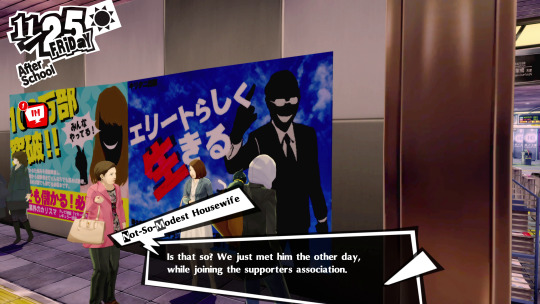
shido has a what now
What's the "supporters association"? In Japanese, it's a 後援会 kouenkai. From Wikipedia:
Koenkai (後援会, lit. "local support groups") are an invaluable tool of Japanese Diet members, especially of the Liberal Democratic Party (LDP). (note: in P5, this is the "Liberal Co-Prosperity Party" or LCP, Shido's original party and the original ruling party.) These groups serve as pipelines through which funds and other support are conveyed to legislators and through which the legislators can distribute favors to constituents in return.
The article is fascinating; do give it a read, as I can't possibly do it justice here. These are massive organisations, and relay vast amounts of cash to their members. They organise endless activities for their members—that meeting at the Wilton Hotel on 5/5 is one. They often require a personal connection to be invited, which is why the Housewife says this to her friend:

... she knows she wasn't invited.
Though koenkai are weaker in modern times, there are many examples of them being involved with corruption; here are a couple.
"The Asahi reported in the mid-1970s that the [koenkai of former Prime Minister Tanaka Kakuei] "virtually controls… agricultural committees, popular welfare committees, election management committees". This thorough penetration of Tanaka's koenkai into all important facets of Niigata's people's lives propelled him into becoming the father figure of the district. After his arrest in 1976 on corruption charges, many of Niigata's residents still expressed deep respect towards him."
"Due to the huge support [former Prime Minister] Takeshita Noboru enjoyed as a result of his koenkai, his electoral district in Shimane came to be known as ‘Takeshita Kingdom'. Despite being embroiled in many political scandals, related to insider trading and corruption (for which he was never charged), Takeshita's immense local support never waned."
so what does this tell us
In short, Shido's conspiracy is not a few corrupt high-level officials. It's not just Shido, Akechi, the SIU Director and those people on the ship. It is a vast organisation.
It recruits people by reputation (remember those five recommendations in the Palace?) from all levels of society—and those recruits then operate as a bloc, networking, doing favours for each other, advancing their mutual interests, connected via a hierarchy to Shido at the top. This is why Shido can control everything.
It also explains why everyone seems to be linked to the conspiracy—including the hapless Principal Kobayakawa. Did you think it was unrealistic for him to be involved? It seems likely that he was just a low-level member of Shido's koenkai.
When Shido needed someone at Shujin to investigate the Phantom Thieves, Kobayakawa was there—because they have people everywhere. A quick phone call from a higher-up in the organisation—the SIU Director, most likely, who we know Kobayakawa speaks to—and he's eating out of Shido's hand. And will do anything he wants....
So Kobayakawa wasn't anybody at all. He wasn't important. He wasn't somehow part of the deep state. He was just one of likely hundreds of thousands of paid-up Shido supporters looking to advance themselves, getting the vote out, and funding the cause.
He was in the right place at the right time. After all, the koenkai got Kobayakawa his job at Shujin. All his hopes for advancement are centred on it:
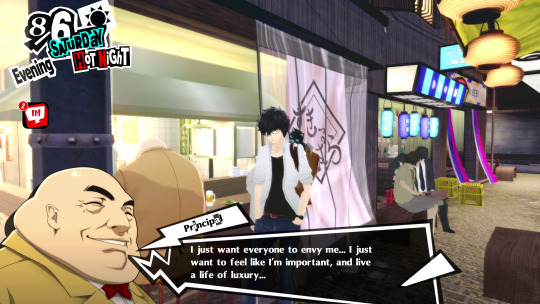
Because just like the two housewives in the underground mall, and probably like everyone else in the koenkai, Kobayakawa is a desperate social climber, impressed by wealth and fame and power and flashy titles.
I hope he thought it was worth it.
revision history
Click here for the latest version.
v1.0 (2023/10/31)—first posted.
217 notes
·
View notes
Text
A rant and theory
It’s really long, but I think I make some valid points.
Supernatural was on for 15 years. There have been interactions with the cast, some crew, some producers, directors, writers, etc. due to the ongoing conventions and the existence of social media. Writers will talk about changes to scripts, actors will talk about filming, directors will talk about why they chose a certain angle.
Given that most of the fans/stans do not personally know any of the people involved or personally know anything about the things that are/aren’t going on, it’s weird the way some fans/stans speak so confidently about what happened with SPN behind-the-scenes, production, writing, casting, you name it!
Especially when it comes to PrequelGate. People will state with their whole chest, that their version of events is absolutely correct. One J is an asshole, and one J is an innocent baby. Which J is which depends on who is talking. It can be either or both. The only thing that all fans who have theories have in common is that there is a definite good guy and a bad guy.
But the Js are still friends. They say they got over it and forgave. Since no one has given any details, I thought I’d join the bandwagon and come up with a theory of my own. One where there is no good guy/bad guy. So here goes.
I fully believe that the story of The Winchesters was not meant to be an AU. It was supposed to take place between 15.19 and 15.20, with Dean and Sam finding out about their parents. They had to switch it to the AU version because of the leak, a new timetable, and the fact that Jared was no longer available. There is also a recent podcast (I don't have a link) where a writer from The Winchesters said that Robbie Thompson, the writer and show runner for The Winchesters, kind of knew that they were only going to get 1 season because of all the mergers/sales of the networks and studios.
Robbie Thompson said in an interview (https://tvline.com/news/the-winchesters-recap-season-1-finale-dean-heaven-multiverse-jensen-ackles-1234942742/) “There was the spot that takes place in between Episodes 19 and 20, when what happens to Dean happens to Dean… So there was an opportunity to tell stories there, but that just didn’t work for me because we wouldn’t have access to Sam in that way, in a way that we could easily explain or at least emotionally explain, and that just didn’t feel like it was a story that certainly I wanted to tell and none of us did.” (Underlining mine) They wouldn’t have access to Sam because Jared could not be involved. Not because no one wanted him, but because he just couldn’t.
The reason I believe this is because of the following.
It starts with Virtual Con (https://www.youtube.com/watch?v=ADYwrZ787a0) held in March 2021. In the video, the question about Chaos Machine projects starts at around 23 minutes. Watch Jared’s face throughout Jensen’s whole answer. He’s nodding along, looking at his screen, and not even showing the slightest surprise in what Jensen is saying. He doesn’t because he already knows. To me, that is the face of someone who already knows what the other person is talking about. Jared already knows which projects Jensen is working on. He knows which alum he is talking about. So he just sits there and lets Jensen answer. His quip at the end that he will also be acting in it is just that, a quip for the fans. Because (supposedly) he is bound by a 5-year contract to CBS. He can not legally get involved in Jensen’s project with WB. He can acknowledge that he knows about it, but he has to show that he is absolutely not involved.
Next is the announcement of The Winchesters in June 2021 by Deadline. There were tweets by Jared that said he was upset that he didn’t know about it and that he wasn’t involved. There was also a tweet directed at Robbie Thompson calling him a back stabber that was later deleted. And, silence from Jensen, because he was unable to come online and address anything because he was on set in Canada.
Things were set in motion that were not meant to be put in motion for a while. I don’t think Chaos Machine was ready to start casting/filming yet. I think Jensen and Jared were trying to make it work with CBS so that Jared could be involved in the prequel. But those talks weren’t finished, or possibly even started yet. But the leak by Deadline, the WB/Discovery merger, and Mark Pedowitz leaving, combined to put pressure to do the show sooner, while Pedowitz was still in charge. If they waited, then nothing might come of Chaos Machine’s deal with WB once the new owners came in. Maybe they were waiting for Jensen to finish shooting The Boys to get together and talk about all this, but they still hadn't.
And this is what Jared was upset about. He thought there was time before the show would start, so was surprised that it was announced without him knowing. It also explains why he thought Robbie Thompson back-stabbed him. Because he was going to be a part of this show, and now he couldn’t. He couldn’t even say he had been part of the development from the beginning because it would be against his contract with CBS. He can’t even say wants to be a part of it now, because again, it would be against his contract with CBS. He’s upset, because he hasn’t had any communication from Jensen about this going through, and Jensen was also unreachable. So he vented online a little.
Once this narrative that Jared was never involved, and would not appear in it, spread, all of them had to run with it. Jensen apologized for not telling Jared. He said he was superstitious. He wanted to tell Jared, but he didn’t have his phone. That he was on set. That Jared couldn’t participate because he was busy. Etc. etc.
But, when Jared spoke with Jensen, and was (possibly) made aware that the news came out because it was leaked, and that they didn’t have time to clue Jared in, and (possibly) they were thinking of doing the show sooner because of WB, Pedowitz, Zaslav, etc., and that they were still in a holding phase, Jared forgave Jensen.
All of the above explains the inconsistencies and “lies” and “tantrums” and finally the forgiveness, and moving on.
I choose to believe that neither Jared nor Jensen are entitled assholes. They do not owe the fans any BTS details.
I’m sure people can tear this apart, but their theories don’t hold up either.
#jensen ackles#jared padalecki#spnfandom#spn#prequelgate#supernatural#the winchesters#supernatural fandom
86 notes
·
View notes
Text
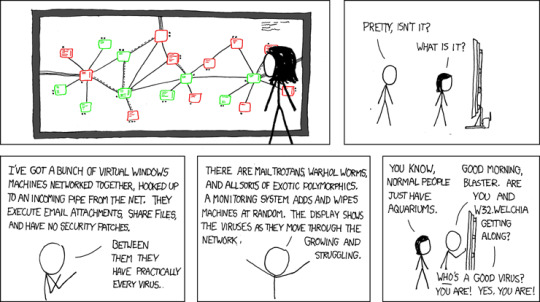
Viruses so far have been really disappointing on the 'disable the internet' front, and time is running out. When Linux/Mac win in a decade or so the game will be over.
Network [Explained]
Transcript Under the Cut
[Megan looking at a large screen with many green and red squares. The squares have writing in them and lines connecting them.]
[Side view. The screen is a huge LCD connected to a wireless router.]
Cueball: Pretty, isn't it?
Megan: What is it?
Cueball: I've got a bunch of virtual Windows machines networked together, hooked up to an incoming pipe from the net. They execute email attachments, share files, and have no security patches.
Cueball: Between them they have practically every virus.
Cueball: There are mail trojans, warhol worms, and all sorts of exotic polymorphics. A monitoring system adds and wipes machines at random. The display shows the viruses as they move through the network. Growing and struggling.
[Cueball walks past the girl and touches the monitor.]
Megan: You know, normal people just have aquariums.
Cueball: Good morning, Blaster. Are you and W32.Welchia getting along?
Cueball: Who's a good virus? You are! Yes, you are!
50 notes
·
View notes
Text

so @blunderbussin gave me an excuse to write an essay about hirasawa and im going to do that instead of anything impactful with my life and it's going to probably get stupid long. oopsie
So the aspect of Hirasawa that intrigues me the most is the lore surrounding the interactive live shows, a form of storytelling he's more or less pioneered. While there seems to be no particular overarching story (anymore. but thats a story for another day), all the stories that are told by the different shows are loosely connected, sharing characters or referencing events in previous shows; as well as being supplemented by sporadic stories that Hirasawa writes about some of the characters.
And listen. When i say 'loosely connected' i mean i have spent hours and hours and hours with my closest friends (who are also hirasawa fans) trying to stitch these events into a semi-cohesive whole because this old man does not give two brass coins for any kind of continuity (and he's really loosey-goosey on any kind of details), which drives me absolutely insane because goddamnit i will make this stupid thing make sense all together.
Also there's really some pretty banger concepts in these lives: machines that enforce the reality of the world based on collective perception, totalitarian government ruled by an alien fern, the green nerve network (its really hard to explain), Sim City as a place, an echo of modern cities in a virtual universe, Layer-Green/Communo Hybridia, the digital sea, timeline hopping cyborgs with terminal self-loathing
im talking about HIM my beloved good times girl, my rotten cheese man btw ↆↆↆↆ

anyway. this is a topic i could literally talk for hours about And I Have. i've spent so much time lovingly crafting theories only for them to have about a million holes shot through them because of some silly detail i completely forgot. oops. but im going to shut up for now before i get into the really deep/silly shit because if i speak about the ascii dragon or luuk sathwan khondiaw i will literally never ever shut up. i am a dork
#susumu hirasawa#into the hirasawa-verse#this is horribly long and kind of rambly and makes no fucking sense at all. oops#just like an ils!!!!! <- im not even kidding#taking you by the shoulders. listen to me i can give you hours upon hours of theories about this. from the timelines to the connections to#anyways.#I DIDNT EVEN TOUCH ON THE FUCKING. EXPLOSION. OR WIWAT. OR THE WAY IDENTITY PLAYED SUCH A HUGE ROLE IN HIS OLDER STORIES AAAAAAAUGH#anyway . :) i will not shut up about this stuff ever#ヒラサワ#<- what he uses to refer to his characters that share his name btw#I POSTED THIS ON THE WRONG FUCKING BLOG AT FIRST but now its fixed :}
24 notes
·
View notes
Text
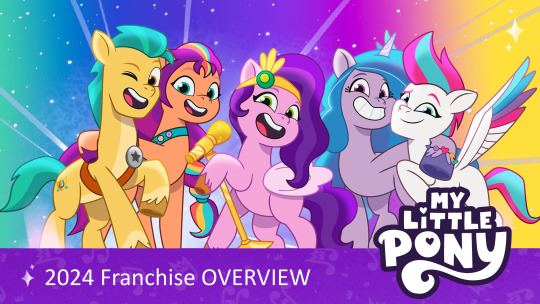
Here's the entire My Little Pony 2024 Franchise Overview presentation. This was originally distributed online in mid-June 2023, and we reported on it then, but there are a couple of details that didn't make it into the post.
Download links
2024 Franchise Overview
2023 Marketing Plans
Hasbro Brands Overview



Slides 2–4. Various random stats which are mostly not important or not properly contextualized. I have just a slight feeling that the stat on slide 3 implying that MLP is bigger than Barbie at the moment is cherrypicked.
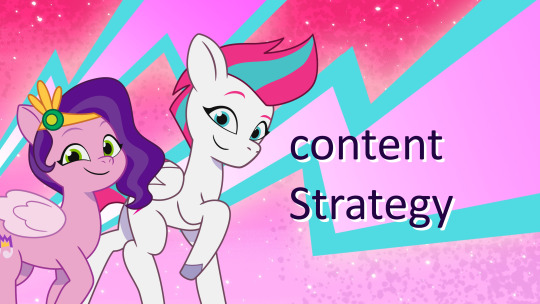

Slides 5–6. Slide 6 is the first slide with specific data about Tell Your Tale viewers. It tells us that Tell Your Tale outperformed Make Your Mark on audience approval and toy purchase basket size, and that it outperformed other franchises on repeat toy purchase rate. There are a few more of these stats on slide 20.
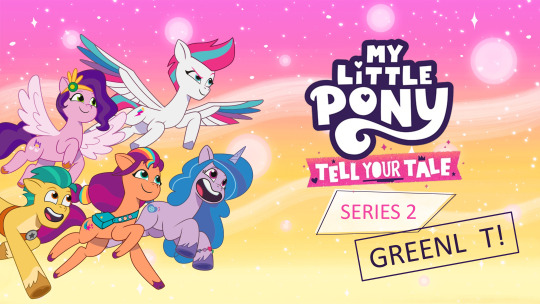


Slides 7–9. Tell Your Tale Season 2 will be real, and will have four specials (the accompanying visuals don't seem to be related, other than the beach stuff for special 2). They didn't really explain what "hair play in every episode" or "more magical moments" will mean, although maybe the former is intended to encourage the purchase of toys.

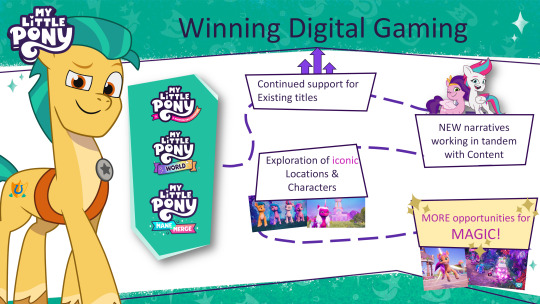

Slides 10–12. This is basically a summary of things that have already been done within the MLP brand over the last few years. "LBE" means "location-based entertainment".
Slide 10 seems to indicate that there are about 7 songs left to be released in Tell Your Tale Season 1.
On slide 12, from left to right, the featured things are the VR book My Little Pony: Virtual Magic; the Sofia Carson-narrated Calm "sleep story"; the I Can Read Comics Level 1 book Sister Switch; the first issue of the G5 IDW comics; the MLP mascots at the Galaxyland theme park in Edmonton, Canada; a render of the lobby of the My Little Pony & Transformers Playlodge in Shanghai; and the "Flight to Equestria" ferris wheel at Galaxyland.


Slides 13–14. Mostly licensed merch, although the Izzy brushable on slide 14 still hasn't been seen anywhere other than this presentation.

Slide 15. Another indication that Make Your Mark won't get anything in 2024: the best they can say about it is that it will "live on Netflix" (i.e. won't be removed from Netflix), which was probably going to happen anyway.
Given the "new episodes weekly" statement, 328 minutes can be neatly divided into 4 22-minute episodes and 48 5-minute episodes, all for Tell Your Tale. Consistent episode lengths make sense for Hasbro, since they intend to license their shows out to TV networks with standard half-hour programming blocks.
"Linear and AVOD" probably refers to traditional TV channels and ad-supported free streaming sites. Some past MLP content is already available on "AVOD" sites such as Pluto TV.
It seems like G5 music will continue to have that generic pop sound.
It's implied that some of the video games shown will be updated in 2024. Maybe not all of them, though, since the MLP Roblox game (Visit Maretime Bay) was shut down in February 2023.


Slides 16–17. They want to grow viewership a lot and convert it to toy purchases. They call Tell Your Tale their "one & only ponable content series"; obviously, maintaining two ongoing animated shows would directly contradict this statement.
The Pipp, Misty, Sunny and Izzy brushables shown all seem to be new, as is the concept art for the accessories of the former three. The Izzy brushable is probably the same one as on slide 14.

Slide 18. They will do a bunch of promo stuff, including releasing a licensed console video game in Q3 2024. The first and third Tell Your Tale specials are to be the tentpole moments (i.e. big marketing focal points) of 2024.


Slides 19–20. Slide 20 features some more new stats on how well Tell Your Tale is performing; it has 177 million cumulative YouTube views, good repeat viewership and better repeat purchase rate than Make Your Mark.

This image is from a different presentation, "2023 Marketing Plans". This slide reveals the Secrets of Starlight logo for the fourth and final My Little Pony: Make Your Mark special.
The "album launch" could be referring to the My Little Pony Theme Song (Sped Up + lofi remixes) EP that was released today. Or maybe something else?

This slide is from the other presentation that was revealed, "Hasbro Brands Overview". It doesn't really reveal anything that wasn't previously known, although it does suggest that Bridlewoodstock will feature in more marketing content through the rest of the year.
Notes
Almost all of the text in the 2024 Franchise Overview presentation is shown in the Calibri font. It doesn't seem like it was originally intended to be that way, and I think it might be due to custom fonts not being loaded properly by whoever converted the presentation to PDF. In spite of this issue, the presentation is likely genuine, evidenced by the high quality images embedded in it, including a shot from a future Tell Your Tale episode on slide 8.
Slides 15 and 18 both note that future plans are subject to change. However, it's probably somewhat unlikely that Hasbro could return to Make Your Mark in 2024. Even if they were to commission more Make Your Mark episodes right now, and could justify the budget for it, it would probably still take more than a year before the first episodes could be completed. I could be wrong about this, but there's nothing to suggest that it would be in the interest of Hasbro, Netflix, Atomic Cartoons or anyone else (except maybe the fans) for Make Your Mark to be renewed after 2023.
While the TYT Audience Report and MLP Shopper Analysis by AIM & We Are Family both seem to be focused on 2- to 8-year-old girls, it's not necessarily an indication that Hasbro is focused solely on this demographic – they might just be the most lucrative demographic, or the one whose analysis produced the best numbers to show to Hasbro's investors and partners.
78 notes
·
View notes
Text
THE ORIGINS OF BUDGIE CITY

Welcome to this informational article where I will be explaining what exactly this "Budgie City" is, where it came from, and in which direction it will be going. So, sit down comfortably - there are some interesting things waiting ahead of you! If you are interested in the lore, visit this article.
What exactly is "Budgie City"?
It is a fictional world that I am actively developing. At the moment, I’m in the process of writing it in the form of a paper draft. I write long texts by hand, and it seems to me that spelling out each letter, unlike typing, helps to approach the composition of sentences more thoughtfully, and to more successfully avoid strange and crooked constructions that will then have to be rewritten and corrected. It is far from the final, but I want to warm up people's interest in this world before the release of a full-fledged work, which is what I am doing now. I will not publish too many pieces of text until I have finished the story completely (though I probably will show some sneak-peeks). For now the content on "Budgie City" is mostly limited to drawings — concepts, sketches and character designs. Gradually, I've been starting to bring this topic to my YouTube channel in order to introduce the setting and concept to my viewers.
You may have seen my first video of Budgie City since 2014, which I have released quite recently — “I am not insane”, a video that focuses on one of the secondary conflicts of the story.

Where did this concept even come from?
It's quite a long story, and it's funny that this year is the ten year anniversary of me registering on the forum called "Budgie City". Yes, it all started with a regular internet forum — a by now almost extinct site format, which in the early 2000s and until about 2016-17 was the main place for interest groups on the internet. Now this has moved almost completely to social media, but before almost any hobby or interest had its own forum with different sections and topics. It saddens me a little that the golden age of forums has already passed.
In 2012, for the New Year, my parents bought me my first budgie — a classic green one, and I named him Gesha. At that time, I was not a regular "user" of the Internet yet. I only started to comprehend the vastness of the virtual network a few months later, and at first it leaned purely on me viewing memes in Google pictures and all sorts of videos on YouTube.
But in the spring of 2013, I discovered these wonderful things known as forums. And it was that point in time when I, having had a budgie with me for a year, decided to find a forum thematically fitting. Upon the request from my country, Google led me straight to the “Budgie City” forum.
The topics on there were something like rooms in a big house. The users randomly surfed through them and followed each other's daily lives. Therefore, Budgie City did actually feel really like being in a virtual society where everyone knows each other. I was getting used to the frequent people, getting to know each person individually. I went to their topics to write comments and answers, they wrote in mine. That's how we existed as this cozy club of interests.
There is an interesting thing with almost every child that is on the Internet — no matter where, in which community — a person with the admin/moder status is perceived as an absolute authority, any response from which causes awe and delight. And there were certain, more active and sociable admins in Budgie City — Anya under the nickname "Phoenix Bird" and Olga under the nickname "Olivka". The "Phoenix Bird" nickname spoke for itself — the image of a large bird of fire that walks around the city and receives admiring glances from everyone, was drawn in my head almost instantly. Olivka didn't have an image yet; I started turning her into a character much later.
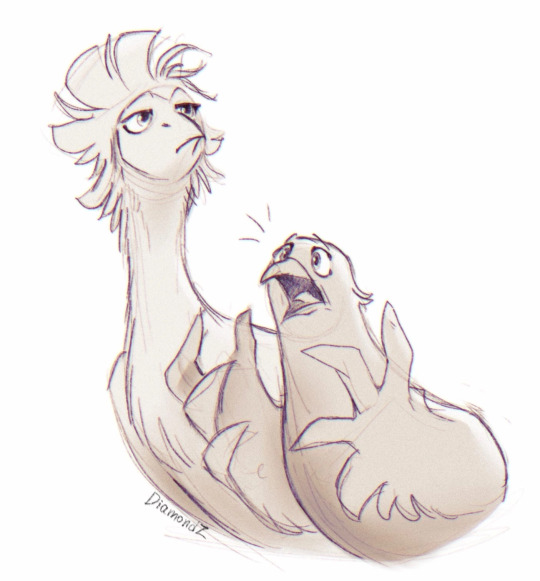
Phoenix and Olivka in their modern designs (2022)
In the early summer of 2014, I read "Warrior Cats", and that’s where the whole story took off. I suddenly felt like I should become a writer too and write my own book. And 12-year-old me, who was spending 80% of my online traffic on the forum, decided to write a story, turning part of the admin staff and the budgies of familiar forum members into their own characters. Phoenix and Olivka turned into birds, the latter in particular acquired an image in the form of a wompoo fruit dove with olive-tinged wings, the budgies of the forum were also turned into their respective characters: Gesha and Yasha (mine); Glasha and Gosha (Hoatzin); Clementine, Jack, Fenya, Nira, Mouse, Castorka, Mithril and Small (Phoenix); Kuzya (Dmitriy68), Milana (Radujniy), Raisin (yyna) and others.
Sections of the forum have turned into parts of the city — the restaurant, the mayor's office, the registry office and nursery, and suburbs with parrots of other species, located on trees surrounding baobabs.
This is how the novel of the same name with the slogan "Feathered Metropolis" was born from the "Budgie City" forum. I posted it in its own topic, had about a dozen readers and, judging by the reviews, they all really liked reading the story. Although, looking back at the writing now... I wouldn't call it something breathtaking. Rather the opposite. But then again, I am now judging from the perspective of a third-year animation director student, and not the fifth grader I was at that time.
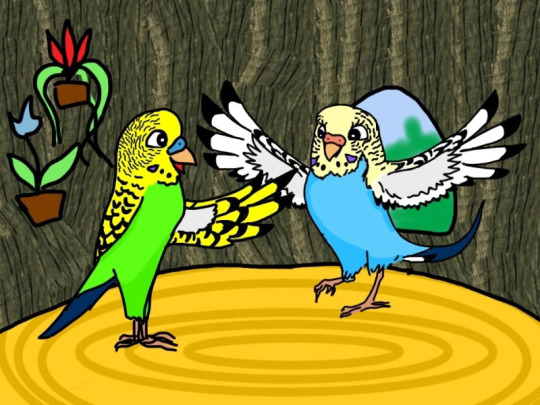
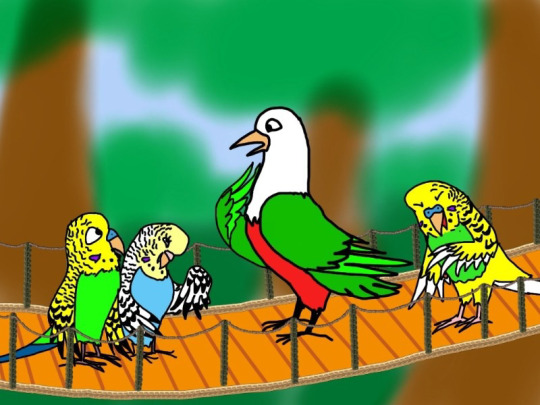
A couple of my original illustrations from 2014
The story was successfully brought to an end in about seven months, and after a while I started writing a sequel — however, the central conflict wasn’t thought out the slightest, so the plot quickly crumbled and was abandoned after several chapters.
Now the original text is lost in the vastness of the web — somewhere there is a piece of the prologue, somewhere even a couple of chapters. But the full version no longer exists — it was published only on the forum, and the said forum, unfortunately was — somewhere around 2019 — ruthlessly deleted from the Internet due to the desolation. All that's left of it are snapshots in the Wayback Machine.
Rewriting from the old version into a new one
In 2017, three years later, I made an attempt to rewrite "Budgie City" from scratch — leaving only the main conflict, the structure of the world, and the set of characters the same, to write a new text out of this "skeleton". Progress did not go beyond the prologue and the first chapter however, and rewriting was abandoned.
The same story with 2019 — a couple of pages, that’s all.

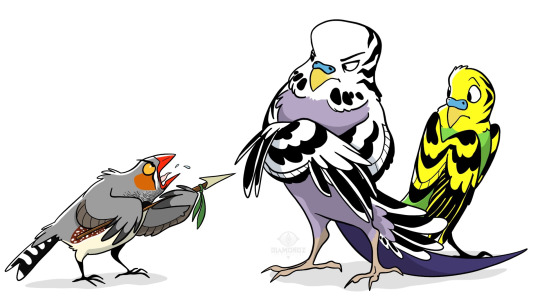
Two artworks from 2019
The next approach took till early 2021 to happen, when the original story turned almost six and a half years old. At that time I was already in the middle of my first year of animation directing at SPbGIKiT (Saint Petersburg State Institute of Film and Television). I wrote the prologue and part of the first chapter and went to proudly tell our master Galina Voropai about my "really cool" world. Galina interrupted me in the middle of the impromptu presentation, after which followed a forty-minute roast, thoroughly and in detail explaining that the "Budgie City" in its concept is a piece of junk that does not have the right to exist in its current form. And all this was in the presence of my classmates in the workshop. I gave up trying to defend myself halfway through, and when it was all over, I got up, quietly thanked Galina for a detailed objective analysis of the shortcomings of my project, went down to the first floor, huddled in a bathroom stall, and burst into tears.
It was the first (and yet the only) time in my life where I was literally crying over my work, and the girls from senior courses came to my howls, and we sat together on the windowsill of a public toilet. I was all red, shaking, and dropping snot, as they tried to calm me down.

(my mental state that day)
After that, I did not return to those written several pages for about a year and a half. I began to doubt whether I should continue at all or if it would just be a waste of time.
After the roast from the master, I went through all five stages of grief:

Yes, that was tough. But after so much time, I was finally able to evaluate the message of this scolding with a cool head and understand that most of the comments were actually really helpful - the conflict and the world did require a lot more careful study and rework. With the next approach, I wrote out all the conflicts, all the character motivations, and made a proper plan. And since the end of last autumn, I have returned to writing. Now I know where the story will begin, where it will head, and how it will end. All the actions performed by the heroes are finally based in actual logic. And, although Galina will not see the final result (she sadly passed away at the end of 2021), I hope that the new version will be one that she would have approved of.
A small FAQ:
Q: When will the book be released?
A: I don't want to make any promises as of now, because writing is a rather spontaneous and uneven process. I write more when I am inspired, and inspiration is impossible to predict. So the answer is simple — it will come out when it's finished :D
Q: Will it be released electronically or in a printed book form? Will I have to pay for reading it?
A: I plan to release the final version "Budgie City" in the same way as the old one — in open access, so that everyone can read it at any time. I will not charge money for reading the electronic version, but if there will be a demand for physical copies, I may release a small print run, which will cost money for those who want to get a copy. But it's a little early to think about that anyway.
Q: How does the world in Budgie City work? How do they live? What is the main conflict of the story?
A: All of this you can find out in this article!
Q: Where can I find more content to this world and story?
A: On this very blog or on my YouTube channel
I hope this article was helpful and informative enough for you to know where "Budgie City" comes from and in which direction it is currently heading. Thank you for reading!
Huge thanks to @annchanorsomethin for helping with translation of this article!
#budgie city#introducing post#information post#writers on tumblr#artists on tumblr#art#original writing#writing#info#lore article#article
69 notes
·
View notes
Text
Hello! This was into response about someone complaining about Hazbin Hotels (admittedly) pretty bad pacing so strap in for 8 paragraphs outlining the history of television and how Hazbin hotel’s terrible pacing fits into this.
So here’s a little (unneeded but still fun) history of television. So as we transitioned from the Radio Era a full season was 39 weeks (3 quarters of a year) and was preformed live, during the rest of the year that time slot would be designated for replacement shows because show hosts have to vacation at some point in their lives.
Anyways due to primitive recording techniques making reruns virtually impossible, the industry standard of replacement shows continued into television. Although finally by mid-fifties reruns were more possible and commonplace. From this point on the number of episodes began to decline, by the late 60’s the 46 episode standard season became 26 instead. (1ep per week is half the year meaning reruns for the other half so that every show could be repeated once a lot easier than the longer seasons of the past )
Essentially broadcast networks wanted more bang for their buck
Then came the miniseries format in the 70’s. Usually about 13 episodes telling stories week to week that were self contained (Think Phineas and Ferb, the episodes have no impact on each other) Also 13 is half of what a normal season was so networks would use this if a project was on the edge of cancellation.
Also in the 70’s networks would cancel shows mid year (now it’s after the November sweeps) so they’d order shows in 12 episode groups and if the ratings weren’t good enough a new one would replace it in January.
By the 90’s it kept getting shorter ordering shows in either 8, 16, or 24 episode seasons. For almost all new shows that a network isn’t sure about they give 8 episodes to test out the waters and see how fans react and that’s what I believe Amazon Prime did for Hazbin Hotel.
And so after an entire history lesson of television, let’s talk about Hazbin Hotel.
So let’s get one thing straight, yeah the pacing of HH is not great and definitely could be improved upon. From what it looks like, we’re supposedly watching a show that has a time span of about 6 months in between 8 episodes which gives no time to develop almost anything but plot relevant to the extermination. However like I just spent the past 4 paragraphs leading up to, season’s episodes are only getting shorter and shorter, not to mention that it’s up to the networks to tell the show how many episodes it’s going to be getting. So with 8 episodes to tell decades worth of planning a world out for Hazbin Hotel I’m sure that’s a little hard, especially with all of the characters that we love and want screen time for (remember how everyone was mad at Encanto for the pacing as well? The plot was there but the movie was too short for the amount of characters and stories that they wanted to tell)
Additionally it’s been said that the team didn’t know that the show was getting a second season until half way through production (I don’t have any sources to back this one up but I’ve heard it going around a few places) so it seems like this season was planned like it was the only season we would be getting which would explain why everything is so fast paced.
Hopefully with that second season (and maybe more) they will feel more fluid and organic but for now we need to understand that this is just the first season and that the rough start shouldn’t be entirely on the blame of the show itself. If your mad about something sure, I’m down to put the blame on those responsible- but I think instead of being mad at the show, or saying “I’m disappointed in the show” we should shift the blame onto the networks who put such small episode constraints on not just Hazbin hotel- but all new shows! Sure if you have a well thought out story that you can tell in 8 episodes then that’s great! But too many shows are forced to rush through their plot because of greedy networks enforcing restraints on the creativity of the shows their hosting
#hazbin hotel#vivziepop#tv shows#history of tv#amazon prime#I wanted to try and take an unbiased perspective#but then again this show has taken over my life so take that as you will#i spent way too long on this#an embarrassing amount of time on this
20 notes
·
View notes
Text
The job of a SOC Analyst
The #1 thing people ask me about is what I do for a job.
I'm a tier 1 SOC Analyst and I'm currently training to do some Cyber Threat Intelligence.
I will explain in detail what I do on a daily basis and why I've decided to do this job... And the negatives.
First of all, what's a SOC. SOC stands for "security operations center". It's a place (in my case virtual as I'm full remote) where a group of people, divided by experience and area of expertise, do the following:
Monitor the activities going on the customer's network or endpoints(= every device connected to the network);
Assess and mitigate alerts coming from the network and/or the endpoint of the client -> These tools send alerts that need to be evaluated and mitigated/responded in a certain amount of time (it depends on the SOC and the type of alert, generally I can assume an amount of time from 15 to 30 minutes per alert. Which is not that much;
Investigate cybersecurity incidents -> the SOC also analyses the kind of "incident" that happens in deep detail by analysing malware, spam emails, the behaviour of users and so on;
If the SOC is big/mature enough there could be some sort of prevention of cybersecurity issues, generally we talk about threat hunting (here for more information on that) and cyber threat intelligence (gathering information from various sources to produce a report about the potential attackers considering also the characteristic of the customer's company such as the size, the geographical area of operations, media exposure, geopolitical issues and what they do - doing this for a bank is different than doing it for a industry)
There are also other functions (such as we have a Security Architect that prepares a personalised solution for each client).
I know what you're thinking. But the AI...
No, they cannot do my job, as the ability of a human to notice patterns and correlate the information among various sources is unique. I memorised, with time, the usual activities my customers do, therefore I can interpret the user actions even with limited sources. And this is just one example.
Soc analysts are roughly divided in three "categories", always keep in mind that every SOC is different and has its own internal rules, that are not to be divulged. This is the rough division I've learned studying cybersecurity and NOT my organisation division.
Tier 1 Analysts are the one that monitors the traffic and activities I've mentioned before. They triage the alerts and if something deserves more investigation or can be discarded. They often perform simple actions of remediation of incidents.
Tier 2 Analysts are the ones that go deeper - they collect malware samples from the incident and analyse it, investigate and remediate more complex security incidents.
Tier 3 Analysts perform more active prevention duties like threat hunting and vulnerability assessments.
Some sources put intelligence activity on the tier 3, others consider it a different activity from the scenario I've described. If a SOC is big enough they might have their own intelligence team separated from the "regular" soc analysts. The rigidity of these roles can vary, as you probably got from my own duties.
On the top we have a SOC manager to coordinate the activities I've described and security architects that design the solution (although the deployment of these solutions can be delegated to the analysts, since we also have to monitor how well these perform).
All these people are usually referred as "blue teamers" btw, which are the ones that perform defensive actions.
A company can have a red team (basically they attack the customer to gain information that the blue team will use to improve their activities). I actually wanted to be a red teamer at first, since it's considered the "cooler" job.
Ok, got it. Now explain to me how you got there since I've never heard anything about this before.
I have a friend that's a system engineer and recommended this job to me.
I studies physics at university but I failed (in my country physics include some computer science classes btw) and I had some related experience I won't share for privacy reasons. No I'm not a criminal lol.
I then started studying - did a bootcamp and got a couple of certifications. Then I got my job.
However. Generally you get a degree in computer science or software engineering, and some universities offer cybersecurity degrees. Unfortunately I cannot tell you what to pick as every university has its own program and I cannot help you with that.
Certifications are a big part of my job unfortunately - mostly because due to how fast it goes you absolutely need to be "on top". It's annoying, yes, I hate it.
However. Consider that once you're hired you definitely will get them paid by your employer - at least in Europe this is on them(idk about the US), but you need some knowledge of cybersecurity to start.
Since some of them are stupid expensive I 100% recommend the compTIA ones. They're basics and respected worldwide. A+, Network+ and Security+ are basics, vendor neutral (which doesn't tie you to a particular "source", as every company works differently), and is relatively cheap (~300€).
Remember that I had previous experience so no one cares that I don't have a degree - I do however and I hope that in the future I will be able to "fix" this.
Great. How do I know if I'm good for this job?
This is on you. However:
One important thing if you don't live in an English speaking country is a good attitude towards foreign languages. I speak 5 for example, but it's an hobby I do since I was a teen;
Can you manage stress? A SOC is a fast paced environment, and you have a limited time to deal with whatever gets thrown at you. You have 15 to 30 minutes to deal with an alert and make a decision. Can you do that without panicking, crying or throwing a tantrum?
Are you a fast learner? You need to learn quickly how to do things, since the tools we use are quite complicated.
Are you willing to work on shifts, Saturdays, Sundays, festivities included? A lot of people can't cope with this and it's fine because it's a massacre. The job is so stressful to the point a lot of people leave cybersecurity because of it. Do not underestimate it, please.
How good are you at remembering random information and making correlations? Because I can remember random bits of information that no one ever thinks of it and it's one of my greatest strengths.
You need to do teamwork and be good with people, customers and so on - you have to explain complicated things you probably read in another language to people that don't know anything about what you do. It's more difficult than most people think.
Procedures are everything here - and for good reasons.
I think this is it.
Money.
USA avg salary: 74 307$ (Glassdoor)
France avg salary: 42 000€ (Glassdoor)
UK avg salary: 28 809 £ (Glassdoor)
There are random numbers I've found online(and with a lot of discrepancies). Consider that you MUST negotiate your salary, and that in certain places you get paid more if you work out of the usual 8-19 work shift. Obv since I live in a different place I cannot tell you if it's worth it - you do your own calculations.
But that's beyond the purpose of this post.
10 notes
·
View notes
Note
There is this argument that I keep hearing from a United States religious leader. He says that deplatforming is an example of how antifascists only make things worse, referring specifically to Milo Yiannopoulos. He says that deplatforming doesn't work because antifascists made him more famous, whereas Yiannopoulos deplatformed himself when he defended pedophilia. This is an annoying argument and it is going virtually unchallenged to a guy that has 70,000 people worth of influence. To avoid reinventing the wheel, is there a strong defense of deplatforming that already exists? Is this worth reintroducing to the discourse, or should I pick a different fight?
We have a looong response to this question, Anon, so here is Part One; Part Two is here.
Antifascists use a strategy of deplatforming to deny fascists access to public space, venues, and resources from which they would otherwise freely broadcast their vile hate and genocidal plans from. Whether it be a public square, a university lecture hall, a social media account, or access to the mass media - antifascists believe that denying fascists the means to disseminate their repugnant views and recruitment messages from is a key component of antifascist work.
Many have argued that deplatforming = denial of free speech rights, but they miss some key distinctions between the two. One is that no one - NO ONE - is obligated to provide fascists with a platform to begin with. Mass media aren't obligated to provide them with interviews and op-eds. Colleges and libraries aren't obligated to provide them with lecture halls and meeting spaces. Social media networks are not obligated to provide them with accounts or access. In all of these cases, there are gatekeepers that everyday make decisions about who can/cannot use the platform in question.
XKCD explains the difference:

Some, like the religious leader you mention, say that deplatforming makes things worse because it gives more attention to fascists than they'd have otherwise. This is another example of the "ignore the nazis and they'll just go away" argument that liberals love to make about how to properly respond to fascists. Unfortunately, ignoring fascists = enabling fascists, as they grow their base and increase their terror campaign against people they don’t like (ethnic/racial/religious minorities, women, LGBTQ+, disabled people, etc.) unopposed. There is no instance in history where a fascist movement was stopped because non-fascists put their heads in the sand and did their best to ignore the fascists, but there are many instances in history where people were forcibly removed, injured, and killed because people chose to ignore the fascists attacking them.
There was a time when fascists would fly the free speech flag to decry antifascist effort to deplatform them; we’d be lying if we said that didn’t result in a momentary amplification of their voice through things like mass media, but that moment has largely passed as media outlets found it increasingly difficult to justify their positions. At the same time, we’d argue that the movement that gained the most through media amplification of antifa deplatforming efforts was the antifa movement itself. Our collective has been around for eight years and we’ve seen antifascist go from being a relatively obscure movement to one that the (former) president of the United States frequently spoke out about/against in international media, almost entirely due to the strategy of deplatforming fascists. So from our perspective, deplatforming had an unintended but welcome effect of making millions aware of the antifascist movement, and drawing thousands upon thousands of people to it.
In Part Two of our response to your query, we look at Milo Yianopoulus - the example cited by the religious leader you reference as evidence that deplatforming backfires + another equally-major fascist figure + get into the argument a bit more.
180 notes
·
View notes
Note
@previous anon: FUCK YOU
Serial Experiments Lain (stylized as serial experiments lain) is a Japanese anime television series created and co-produced by Yasuyuki Ueda, written by Chiaki J. Konaka and directed by Ryūtarō Nakamura. Animated by Triangle Staff and featuring original character designs by Yoshitoshi ABe, the series was broadcast for 13 episodes on TV Tokyo and its affiliates from July to September 1998. The series follows Lain Iwakura, an adolescent girl in suburban Japan, and her relation to the Wired, a global communications network similar to the internet.
Lain features surreal and avant-garde imagery and explores philosophical topics such as reality, identity, and communication.[3] The series incorporates creative influences from computer history, cyberpunk, and conspiracy theory. Critics and fans have praised Lain for its originality, visuals, atmosphere, themes, and its dark depiction of a world fraught with paranoia, social alienation, and reliance on technology considered insightful of 21st century life. It received the Excellence Prize at the Japan Media Arts Festival in 1998.
Contents1 Plot 2 Characters 3 Production 3.1 Writing 3.2 Character design 3.3 Themes 3.4 Apple computers 4 Broadcast and release history 4.1 Episode list 5 Reception 6 Related media 6.1 Art books 6.2 Soundtracks 6.3 Video game 7 See also 8 References 9 Further reading 10 External links
Plot
Lain Iwakura, a junior high school girl, lives in suburban Japan with her middle-class family, consisting of her inexpressive older sister Mika, her emotionally distant mother, and her computer-obsessed father; Lain herself is somewhat awkward, introverted, and socially isolated from most of her school peers. The status-quo of her life becomes upturned by a series of bizarre incidents that start to take place after she learns that girls from her school have received an e-mail from a dead student, Chisa Yomoda, and she pulls out her old computer in order to check for the same message. Lain finds Chisa telling her via email that she is not dead but has merely "abandoned her physical self" and is alive deep within the virtual realm of the Wired itself, where she claims she has found "God" there. From this point, Lain is caught up in a series of cryptic and surreal events that see her delving deeper into the mystery of the network in a narrative that explores themes of consciousness, perception, and the nature of reality.
"The Wired" is a virtual realm that contains and supports the very sum of all human communication and networks, created with the telegraph, televisions, and telephone services, and expanded with the Internet, cyberspace, and subsequent networks. The series assumes that the Wired could be linked to a system that enables unconscious communication between people and machines without physical interface. The storyline introduces such a system with the Schumann resonances, a property of the Earth's magnetic field that theoretically allows for unhindered long-distance communications. If such a link were created, the network would become equivalent to Reality as the general consensus of all perceptions and knowledge. The increasingly thin invisible line between what is real and what is virtual/digital begins to slowly shatter.
Masami Eiri is introduced as the project director on Protocol Seven (the next-generation Internet protocol in the series' time-frame) for major computer company Tachibana General Laboratories. He had secretly included code of his very own creation to give himself absolute control of the Wired through the wireless system described above. He then "uploaded" his own consciousness into the Wired and "died" a few days after, leaving only his physical self behind. These details are unveiled around the middle of the series, but this is the point where the story begins. Masami later explains that Lain is the artifact by which the wall between the virtual and material worlds is to fall, and that he needs her to go into the Wired and "abandon the flesh", as he did, to achieve his plan. The series sees him trying to convince her through interventions, using the promise of unconditional love, romantic seduction and charm, and even, when all else fails, threats and force.
In the meantime, the anime follows a complex game of hide-and-seek between the "Knights of the Eastern Calculus" (based on the Knights of the Lambda Calculus), hackers whom Masami claims are "believers that enable him to be a God in the Wired", and Tachibana General Laboratories, who try to regain control of Protocol Seven. In the end, the viewer sees Lain realizing, after much introspection, that she has absolute control over everyone's mind and over reality itself. Her dialogue with different versions of herself shows how she feels shunned from the material world, and how she is afraid to live in the Wired, where she has the possibilities and responsibilities of an almighty goddess. The last scenes feature her erasing everything connected to herself from everyone else's memories of her and everything else that has happened since the premiere. She is last seen, unchanged, encountering her oldest and closest friend Alice once again, who is now married. Lain promises herself that she and Alice will surely meet again anytime as Lain can literally go and be anywhere she desires between both worlds.
Characters
Lain Iwakura (岩倉 玲音, Iwakura Rein)
Voiced by: Kaori Shimizu (Japanese); Bridget Hoffman4
The titular character of the series. Lain is a fourteen-year-old girl who uncovers her true nature through the series. She is first depicted as a shy junior high school student with few friends or interests. She later grows multiple bolder personalities, both in the physical world and the Wired, and starts making more friends. As the series progresses, she eventually comes to discover that she is, in reality, merely an autonomous, sentient computer program in the physical and corporeal form of a human being, designed to sever the invisible barrier between the Wired and the real world. In the end, Lain is challenged to accept herself as a de facto goddess for the Wired, having become an omnipotent and omnipresent virtual being with worshippers of her own, as well as an ability to exist beyond the borders of devices, time, or space.
Masami Eiri (英利 政美, Eiri Masami)
Voiced by: Shō Hayami (Japanese); Kirk Thornton4
The key designer of Protocol Seven. While working for Tachibana General Laboratories, he illicitly included codes enabling him to control the whole protocol at will and embedded his own mind and will into the seventh protocol. Because of this, he was fired by Tachibana General Laboratories, and was found dead not long after. He believes that the only way for humans to evolve even further and develop even greater abilities is to absolve themselves of their physical and human limitations, and to live as virtual entities—or avatars—in the Wired for eternity. He claims to have been Lain's creator all along, but was in truth standing in for another as an acting god, who was waiting for the Wired to reach its more evolved current state: Lain herself.
According to another Lain, however, he has never truly existed all along and would not have had any self-obsessed ideas about being God if he had.
Yasuo Iwakura (岩倉 康男, Iwakura Yasuo)
Voiced by: Ryūsuke Ōbayashi (Japanese); Barry Stigler4
Lain's father. Passionate about computers and electronic communication, he works with Masami Eiri at Tachibana General Laboratories. He subtly pushes Lain, his "youngest daughter", towards the Wired and monitors her development until she becomes more and more aware of herself and of her raison d'être. He eventually leaves Lain, telling her that although he did not enjoy playing house, he genuinely loved and cared for her as a real father would. Despite Yasuo's eagerness to lure Lain into the Wired, he warns her not to get overly involved in it or to confuse it with the real world.
Miho Iwakura (岩倉 美穂, Iwakura Miho)
Voiced by: Rei Igarashi (Japanese); Dari Lallou Mackenzie4
Lain's mother. Although she dotes on her husband, she is indifferent towards both her kids. Like her husband, she ends up leaving Lain. She is a computer scientist.
Alice Mizuki (瑞城 ありす, Mizuki Arisu)
Voiced by: Yōko Asada (Japanese); Emily Brown4
Lain's classmate and only true friend throughout the series. She is very sincere and has no discernable quirks. She is the first to attempt to help Lain socialize; she takes her out to a nightclub. From then on, she tries her best to look after Lain. Alice, along with her two best friends Julie and Reika, were taken by Chiaki Konaka from his previous work, Alice in Cyberland.
Mika Iwakura (岩倉 美香, Iwakura Mika)
Voiced by: Ayako Kawasumi (Japanese); Patricia Ja Lee4
Lain's older sister, an apathetic sixteen-year-old high school student. She seems to enjoy mocking Lain's behavior and interests. Mika is considered by Anime Revolution to be the only normal member of Lain's family:[5] she sees her boyfriend in love hotels, is on a diet, and shops in Shibuya. At a certain point in the series, she becomes heavily traumatized by violent hallucinations; while Lain begins freely delving into the Wired, Mika is taken there by her proximity to Lain, and she gets stuck between the real world and the Wired.[6]
Taro (タロウ, Tarō)
Voiced by: Keito Takimoto (Japanese); Brianne Siddall4
A young boy of about Lain's age. He occasionally works for the Knights to bring forth "the one truth". Despite this, he has not yet been made a member, and knows nothing of their true intentions. Taro loves VR games and hangs out all day at Cyberia with his friends, Myu-Myu and Masayuki. He uses special technology, such as custom Handi Navi and video goggles. Taro takes pride in his internet anonymity, and he asks Lain for a date with her Wired self in exchange for information.
Office Worker
Voiced by: Shigeru Chiba
A top executive from Tachibana General Laboratories. He has a personal agenda, which he carries out with the help of the Men in Black. He looks forward to the arrival of a real God through the Wired, and is the man behind the Knights' mass assassination. There are many things he does not know about Lain, but he would rather ask questions about her than disclose his agenda.
Men in Black
Karl Haushoffer (カール・ハウスホッファ, Kāru Hausuhoffa), Voiced by: Jouji Nakata
Lin Suixi (Chinese: 林随錫; pinyin: Lín Suíxī), Voiced by: Takumi Yamazaki
The Men in Black work for the above "Office Worker" in tracking down and murdering all of the members of the Knights. They are not told the true plan, but they know that Masami Eiri is somehow involved, despite having been "killed." They see no need for an almighty, all-powerful God—let alone Lain—in the Wired.
Chisa Yomoda (四方田 千砂, Yomoda Chisa)
Voiced by: Sumi Mutoh (Japanese); Lia Sargent4
A teenage girl who committed suicide at the beginning of the series. After her death, she e-mails Lain, Julie, and a few other kids, saying that she is still alive in the Wired, leading to the series events.
Reika Yamamoto (山本 麗華, Yamamoto Reika)
Voiced by: Chiharu Tezuka (Japanese); Lenore Zann4
One of Alice's friends from school. She does not seem to care for Lain, since she harasses her quite a lot. She is more serious than Julie, and also somewhat meaner.
Julie Kato (加藤 樹莉, Katō Juri)
Voiced by: Manabi Mizuno (Japanese); Gracie Moore4
Another friend of Alice. She also harasses Lain, but not as severely as Reika does. She is sometimes insensitive to other people's feelings.
Masayuki (マサユキ)
Voiced by: Sora Fujima (Japanese); Dorothy Elias-Fahn (English)
Taro's best friend. He is usually seen hanging out with Taro and Myu-Myu.
Myu-Myu (ミューミュウ, Myūmyuu)
Voiced by: Yuki Yamamoto (Japanese); Sandy Fox (English)
A young girl who hangs out with Taro and Masayuki at Cyberia Café. She has feelings for Taro, so she gets jealous when he flirts with Lain.
Narrator
Voiced by: Takashi Taniguchi (Japanese); Paul St. Peter (English)
Production
Serial Experiments Lain was conceived, as a series, to be original to the point of it being considered "an enormous risk" by its producer Yasuyuki Ueda.[7]
Producer Ueda had to answer repeated queries about a statement made in an Animerica interview.[6][8][9] The controversial statement said Lain was "a sort of cultural war against American culture and the American sense of values we [Japan] adopted after World War II".[10] He later explained in numerous interviews that he created Lain with a set of values he took as distinctly Japanese; he hoped Americans would not understand the series as the Japanese would. This would lead to a "war of ideas" over the meaning of the anime, hopefully culminating in new communication between the two cultures. When he discovered that the American audience held the same views on the series as the Japanese, he was disappointed.[9]
The Lain franchise was originally conceived to connect across forms of media (anime, video games, manga). Producer Yasuyuki Ueda said in an interview, "the approach I took for this project was to communicate the essence of the work by the total sum of many media products". The scenario for the video game was written first, and the video game was produced at the same time as the anime series, though the series was released first. A dōjinshi titled "The Nightmare of Fabrication" was produced by Yoshitoshi ABe and released in Japanese in the artbook An Omnipresence in Wired. Ueda and Konaka declared in an interview that the idea of a multimedia project was not unusual in Japan, as opposed to the contents of Lain, and the way they are exposed.[11]
Writing
The authors were asked in interviews if they had been influenced by Neon Genesis Evangelion, in the themes and graphic design. This was strictly denied by writer Chiaki J. Konaka in an interview, arguing that he had not even seen Evangelion until he finished the fourth episode of Lain. Being primarily a horror movie writer, his stated influences are Godard (especially for using typography on screen), The Exorcist, Hell House, and Dan Curtis's House of Dark Shadows. Alice's name, like the names of her two friends Julie and Reika, came from a previous production from Konaka, Alice in Cyberland, which in turn was largely influenced by Alice in Wonderland. As the series developed, Konaka was "surprised" by how close Alice's character became to the original Wonderland character.[12]
A young girl in a white shift sits with her back to us in the dark, focusing her attention on many glowing computer screens which surround her.
Lain's custom computer features holographic displays and liquid carbon dioxide cooling.
Vannevar Bush (and memex), John C. Lilly, Timothy Leary and his eight-circuit model of consciousness, Ted Nelson and Project Xanadu are cited as precursors to the Wired.[11] Douglas Rushkoff and his book Cyberia were originally to be cited as such,[6] and in Lain Cyberia became the name of a nightclub populated with hackers and techno-punk teenagers. Likewise, the series' deus ex machina lies in the conjunction of the Schumann resonances and Jung's collective unconscious (the authors chose this term over Kabbalah and Akashic Record).[10] Majestic 12 and the Roswell UFO incident are used as examples of how a hoax might still affect history, even after having been exposed as such, by creating sub-cultures.[10] This links again to Vannevar Bush, the alleged "brains" of MJ12. Two of the literary references in Lain are quoted through Lain's father: he first logs onto a website with the password "Think Bule Count One Tow" [sic] ("Think Blue, Count Two" is an Instrumentality of Man story featuring virtual persons projected as real ones in people's minds);[13] and his saying that "madeleines would be good with the tea" in the last episode makes Lain "perhaps the only cartoon to allude to Proust".
[14][15]
Character design
A young girl in a white shift kneels facing us with scissors in her hand, and hanks of her own hair on the ground, leaving one forelock uncut. The background is blue.
ABe came up with Lain's hair by imagining Lain cutting it herself and making a ponytail of what was left.[8] This was later included in his An Omnipresence in Wired artbook.[16]
Yoshitoshi ABe confesses to have never read manga as a child, as it was "off-limits" in his household.[17] His major influences are "nature and everything around him".[6] Specifically speaking about Lain's character, ABe was inspired by Kenji Tsuruta, Akihiro Yamada, Range Murata and Yukinobu Hoshino.[8] In a broader view, he has been influenced in his style and technique by Japanese artists Kyosuke Chinai and Toshio Tabuchi.[6]
The character design of Lain was not ABe's sole responsibility. Her distinctive left forelock for instance was a demand from Yasuyuki Ueda. The goal was to produce asymmetry to reflect Lain's unstable and disconcerting nature.[18] It was designed as a mystical symbol, as it is supposed to prevent voices and spirits from being heard by the left ear.[8] The bear pajamas she wears were a demand from character animation director Takahiro Kishida. Though bears are a trademark of the Konaka brothers, Chiaki Konaka first opposed the idea.[12] Director Nakamura then explained how the bear motif could be used as a shield for confrontations with her family. It is a key element of the design of the shy "real world" Lain (see "mental illness" under Themes).[12] When she first goes to the Cyberia nightclub, she wears a bear hat for similar reasons.[18] Retrospectively, Konaka said that Lain's pajamas became a major factor in drawing fans of moe characterization to the series, and remarked that "such items may also be important when making anime".[12]
ABe's original design was generally more complicated than what finally appeared on screen. As an example, the X-shaped hairclip was to be an interlocking pattern of gold links. The links would open with a snap, or rotate around an axis until the moment the " X " became a " = ". This was not used as there is no scene where Lain takes her hairclip off.[19]
Themes
Serial Experiments Lain is not a conventionally linear story, being described as "an alternative anime, with modern themes and realization".[20] Themes range from theological to psychological and are dealt with in a number of ways: from classical dialogue to image-only introspection, passing by direct interrogation of imaginary characters.
Communication, in its wider sense, is one of the main themes of the series,[21] not only as opposed to loneliness, but also as a subject in itself. Writer Konaka said he wanted to directly "communicate human feelings". Director Nakamura wanted to show the audience — and particularly viewers between 14 and 15—"the multidimensional wavelength of the existential self: the relationship between self and the world".[11]
Loneliness, if only as representing a lack of communication, is recurrent through Lain.[22] Lain herself (according to Anime Jump) is "almost painfully introverted with no friends to speak of at school, a snotty, condescending sister, a strangely apathetic mother, and a father who seems to want to care but is just too damn busy to give her much of his time".[23] Friendships turn on the first rumor;[22][24] and the only insert song of the series is named Kodoku no shigunaru, literally "signal of loneliness".[25]
A series of drawings depicting the different personalities of Lain—the first shows shy body language, the second shows bolder body language, and the third grins in an unhinged fashion.
The different personalities of Lain have their names written using different scripts.
Mental illness, especially dissociative identity disorder, is a significant theme in Lain:[19] the main character is constantly confronted with alter-egos, to the point where writer Chiaki Konaka and Lain's voice actress Kaori Shimizu had to agree on subdividing the character's dialogues between three different orthographs.[19] The three names designate distinct "versions" of Lain: the real-world, "childish" Lain has a shy attitude and bear pajamas. The "advanced" Lain, her Wired personality, is bold and questioning. Finally, the "evil" Lain is sly and devious, and does everything she can to harm Lain or the ones close to her.[12] As a writing convention, the authors spelled their respective names in kanji, katakana, and roman characters (see picture).[26]
Reality never has the pretense of objectivity in Lain.[27] Acceptations of the term are battling throughout the series, such as the "natural" reality, defined through normal dialogue between individuals; the material reality; and the tyrannic reality, enforced by one person onto the minds of others.[22] A key debate to all interpretations of the series is to decide whether matter flows from thought, or the opposite.[22][28] The production staff carefully avoided "the so-called God's Eye Viewpoint" to make clear the "limited field of vision" of the world of Lain.[27]
Theology plays its part in the development of the story too. Lain has been viewed as a questioning of the possibility of an infinite spirit in a finite body.[29] From self-realization as a goddess to deicide,[14] religion (the title of a layer) is an inherent part of Lain's background.[29]
Apple computers
Lain contains extensive references to Apple computers, as the brand was used at the time by most of the creative staff, such as writers, producers, and the graphical team.[12] As an example, the title at the beginning of each episode is announced by the Apple computer speech synthesis program PlainTalk, using the voice "Whisper", e.g. say -v Whisper "Weird: Layer zero one". Tachibana Industries, the company that creates the NAVI computers, is a reference to Apple computers: the tachibana orange is a Japanese variety of mandarin orange. NAVI is the abbreviation of Knowledge Navigator, and the HandiNAVI is based on the Apple Newton, one of the world's first PDAs. The NAVIs are seen to run "Copland OS Enterprise" (this reference to Copland was an initiative of Konaka, a declared Apple fan),[12] and Lain's and Alice's NAVIs closely resembles the Twentieth Anniversary Macintosh and the iMac respectively. The HandiNAVI programming language, as seen on the seventh episode, is a dialect of Lisp; the Newton also used a Lisp dialect (NewtonScript). The program being typed by Lain can be found in the CMU AI repository;[30] it is a simple implementation of Conway's Game of Life in Common Lisp.
During a series of disconnected images, an iMac and the Think Different advertising slogan appears for a short time, while the Whisper voice says it.[31] This was an unsolicited insertion from the graphic team, also Mac-enthusiasts.[12] Other subtle allusions can be found: "Close the world, Open the nExt" is the slogan for the Serial Experiments Lain video game. NeXT was the company that produced NeXTSTEP, which later evolved into Mac OS X after Apple bought NeXT. Another example is "To Be Continued." at the end of episodes 1–12, with a blue "B" and a red "e" on "Be"; this matches the original logo of Be Inc., a company founded by ex-Apple employees and NeXT's main competitor in its time.[32]
Broadcast and release history
Serial Experiments Lain was first aired on TV Tokyo and its affiliates on July 6, 1998, and concluded on September 28, 1998, with the thirteenth and final episode. The series consists of 13 episodes (referred to in the series as "Layers") of 24 minutes each, except for the sixth episode, Kids (23 minutes 14 seconds). In Japan, the episodes were released in LD, VHS, and DVD with a total of five volumes. A DVD compilation named "Serial Experiments Lain DVD-BOX Яesurrection" was released along with a promo DVD called "LPR-309" in 2000.[33] As this box set is now discontinued, a rerelease was made in 2005 called "Serial Experiments Lain TV-BOX". A 4-volume DVD box set was released in the US by Pioneer/Geneon. A Blu-ray release of the anime was made in December 2009 called "Serial Experiments Lain Blu-ray Box| RESTORE".[34][35][36][37] The anime series returned to US television on October 15, 2012, on the Funimation Channel.[38] The series' opening theme, "Duvet", was written and performed by Jasmine Rodgers and the British band Bôa. The ending theme, "Distant Scream" (遠い叫び, Tōi Sakebi), was written and composed by Reichi Nakaido.
The anime series was licensed in North America by Pioneer Entertainment (later Geneon USA) on VHS and DVD in 1999. However, the company closed its USA division in December 2007 and the series went out-of-print as a result.[39] However, at Anime Expo 2010, North American distributor Funimation announced that it had obtained the license to the series and re-released it in 2012.[40]
Episode list
No. Title Directed by Original air date
1 "Weird" Ryūtarō Nakamura July 6, 1998
A high school girl commits suicide by jumping off a rooftop late at night. A week later, students are getting emails from the girl, named Chisa Yomoda, which claim that she only gave up her body, but is actually still alive inside the virtual world known as the Wired, saying that there is a God that exists there. After getting one of these emails, introverted fourteen-year-old Lain Iwakura becomes much more interested in computers and asks her techie father, Yasuo Iwakura, for a new NAVI computer system. When she returns to school the following day, the blackboard writes a subliminal message, inviting her to come to the Wired as soon as she can, revealed to be written by Chisa herself.
2 "Girls" Ryūtarō Nakamura July 13, 1998
At Cyberia, a hardcore techno club, a man buys a nanomachine drug called Accela. On the way to school the next day, Alice Mizuki, along with her friends Julie and Reika, tell Lain they saw her during their first visit to Cyberia, but with a far more vigorous and forceful personality. Lain has her father set up her NAVI computer system at home later that evening. After some persuasion, Lain decides to join Alice at Cyberia that night to prove that she was not there before. However, Lain becomes involved with a shooting in the club by the same man under the influence of Accela. She approaches the man, saying that everyone is connected in the Wired no matter where they are. This leads the man to shoot himself out of psychological shock and trauma.
3 "Psyche" Jōhei Matsuura July 20, 1998
The following day, Lain is scolded by her cold mother, Miho Iwakura, for waking up too late. When she leaves the house, she believes she is being spied on when she sees a black car parked near her house. Furthermore, she hears a voice calling out to her when she enters the train, telling her that she is not alone. Her life is thrown into further disarray when she is anonymously sent a mysterious computer chip. She asks her father what it is, but he says he does not know. When she goes to see Taro, with his friends Myu-Myu and Masayuki, at Cyberia, he recalls seeing Lain on the Wired once, noting her Wired personality being the complete opposite of her restrained real world personality. Mika Iwakura, Lain's older sister, comes home the next day, only to see Lain not acting herself as she starts to modify and upgrade her NAVI computer system.
4 "Religion" Akihiko Nishiyama July 27, 1998
Rumors are flying around school and on the Wired in regards to numerous senior students of various high schools committing suicide, with each of the deceased being addicted to the online action game known as PHANTOMa. Interested, Lain investigates only to discover that the game was glitched with a tag game for kids, in which a little girl scares the students to their deaths. Moreover, she finds out that the deaths were most likely caused by the elite secretive hacker group known as the Knights of the Eastern Calculus. Later at night, she senses the Men in Black, who had been spying on her earlier. When she tells the two to go away, a sound wave penetrates through her window, causing the two to fall back and drive away in their black car.
5 "Distortion" Masahiko Murata August 3, 1998
Amidst the events surrounding Tokyo having its traffic information transmission system hacked to cause deliberate accidents, Lain experiences a series of hallucinations that teach her the nature of the Wired in relation to the real world, by means of inanimate objects in her room and eventually her parents. In the meantime, Mika is driven to terror from the Knights repeatedly communicating in unusual ways for her to "fulfill the prophecy."
6 "KIDS" Ryūtarō Nakamura August 10, 1998
At night, when Yasuo checks on Lain, he sees a dramatic change in her room arrangement and the upgrades on her NAVI computer system, which worries him. As Lain hangs out with Alice, along with Julie and Reika, in the district, she notices that children are looking up into the sky and raising their arms, only to realize that they are looking at an image of herself that appears in the sky. Lain searches for the reason behind the strange happenings and finds Professor Hodgeson, the creator of KIDS, an experiment that started fifteen years ago that tried to gather psi energy from children and store it, though the result of the project destroyed the children. Now it seems that the Knights have gotten hold of the project's schematics. When the Men in Black return, Lain goes outside to see them. The coolant system in her room bursts, leading the Men in Black to confirm that the Knights planted a parasite bomb there.
7 "SOCIETY" Jōhei Matsuura August 17, 1998
As Lain gets more and more involved in the Wired world, albeit at home and at school, Alice starts to worry about her closing up again. It is reported that the Knights cracked the firewall of the information control center of the Wired. As the activity of the Knights begins to surface, the network is in search for Lain. The Men in Black ask Lain to follow them to an office in the Tachibana General Laboratories, where the Office Worker in charge of the Men in Black, after her help of fixing his computer, shows Lain a projection of herself in the Wired taking out one of the members of the Knights. After the Office Worker deduces that Lain in the real world and in the Wired are one and the same, he questions her about her origins. However, she breaks down for not knowing, altering her timid personality to that of a more serious one before she shoves her way out of the room.
8 "RUMORS" Shigeru Ueda August 24, 1998
Lain's family has been acting weird lately, much to her surprise. Upon further investigation, Lain disbelieves that she is omnipresent in the Wired, while she is merely a body, more or less a projection of herself, in the real world. A rumor is spread in the Wired about Alice having sexual fantasies about a male teacher, and a second one says that Lain has spread the first. To cope with the distress of rejection, Lain acts directly on reality for the first time, finding out that she can "delete" the event of the rumors. A lookalike duplicate of herself with its own distinct personality starts appearing more frequently, which leads her to question her own existence.
9 "PROTOCOL" Akihiko Nishiyama August 31, 1998
Throughout the episode, background information is being shown from "archives". Information regarding the Roswell UFO incident, the Majestic 12, which was formed by President Harry S. Truman, engineer Vannevar Bush, who developed what is called memex, physician John C. Lilly, who conducted experiments with dolphin communication, pioneer Ted Nelson, who founded Project Xanadu, and the Schumann resonances are all mentioned, explaining how the human consciousness can be communicated through a network without the use of a device. It is also noted that a man named Masami Eiri has suddenly committed suicide. During that time, Lain gets a computer microchip from J.J., the disc jockey from Cyberia. She then asks Taro on a "date" and takes him to her home, where she asks him about the microchip. After becoming frightened, he admits it is a computer code made to disrupt human memory, and it was made by the Knights. Although he defends them, he admits not knowing much about them. He later kisses Lain before leaving.
10 "LOVE" Masahiko Murata September 7, 1998
As both are seen to have switched bodies, Eiri introduces himself to Lain as the creator of Protocol Seven, saying that Lain no longer needs to have a body in order to be alive. As she, back in her own body, comes home, Yasuo says his farewell after realizing she knows the truth behind her existence. Eiri is considered the God of the Wired because he explained that he is worshiped by the Knights. Knowing this, Lain deals with the Knights once and for all by leaking a list of all of its members onto the Wired, leaving a trail of murder by the Men in Black and suicide in its wake. Even with the Knights gone, Eiri still claims he is the God of the Wired, since he says that the real Lain exists in the Wired, not the real world.
11 "Infornography" Jōhei Matsuura September 14, 1998
Lain lies exhausted in her room, and wakes up to find herself all wrapped in electrical cords. After a really long and complicated memory flashback, seen throughout the series, Eiri appears in her room and congratulates her, for having succeeded in downloading her NAVI into her own brain to see and hear all that is happening. However, he warns her about her "hardware capacity," and that she is merely a sentient and autonomous software computer program with a physical body in the form of a teenage human girl. Lain later appears to Alice in her room to make things right with her again concerning the false rumors. Lain declares that anything is possible now, as devices are no longer needed anymore to enter the Wired freely. The next day, nobody seems to remember the rumored incidents and Lain smiles at Alice's complicity.
12 "Landscape" Ryūtarō Nakamura September 21, 1998
Lain witnesses the frontier between the physical and the Wired worlds finally beginning to collapse. The Men in Black are approached by their Officer Worker, who gives them a final "payment" for their services, telling them to leave town away from any power lines or satellite coverage. After he leaves, both Men in Black suffer death from an image of Lain etched in their retinas. Alice enters Lain's eerie house and goes inside her room. Lain explains that she is actually a computerized program designed to destroy the barrier between the two worlds. Lain is still affixed on the fact that humans no longer need a physical body to stay alive, but Alice shows that her heartbeat proves otherwise. Suddenly, Eiri, first unseen to Alice, appears behind Lain, assuming she needs to be "debugged". Lain argues that Eiri was just an "acting god", for she is the true Goddess of the Wired. Eiri retaliates by transforming into a monstrous form to attain the vastly limitless power and strength that she possesses, but Lain manages to crush Eiri with her electrical equipment, wiping him out for good.
13 "Ego" Ryūtarō Nakamura September 28, 1998
Lain's attempts to protect her from Eiri's attack result in traumatizing Alice, Lain's only true friend; in order to fix this, Lain decides to do a "factory reset" on her life, deleting herself from everyone's memory. Distraught from doing so, Lain is determined to discover her true form and identity and takes radical action. She is confronted by her separate bolder self of the Wired, who reminds her that the Wired is not an upper layer of the real world. Her bolder Wired self then assures her that she is the true Goddess of the Wired, saying she is an omnipotent and omnipresent virtual being that can go and be anywhere she desires and merely watch the real world from afar. After causing her bolder self to disappear, Lain sees her father. Alice, now older with a spouse, spots Lain standing on an overpass, having some déjà vu about Lain but not recognizing who she is. Alice says goodbye and that she may run into Lain again someday. Lain asserts that this is true, since she is everywhere at once.
Reception
A suburban scene on a sunny day, showing houses and telegraph poles, but the shadows contain unnatural red splotches.
Lain's neighborhood. The "blood pools" represent the Wired's presence "beneath the surface" of reality.[6]
Serial Experiments Lain was first broadcast in Tokyo at 1:15 a.m. JST. The word "weird" appears almost systematically in English language reviews of the series,[23][41][42][43][44] or the alternatives "bizarre",[45] and "atypical",[46] due mostly to the freedoms taken with the animation and its unusual science fiction themes, and due to its philosophical and psychological context. Critics responded positively to these thematic and stylistic characteristics, and it was awarded an Excellence Prize by the 1998 Japan Media Arts Festival for "its willingness to question the meaning of contemporary life" and the "extraordinarily philosophical and deep questions" it asks.[47]
According to Christian Nutt from Newtype USA, the main attraction to the series is its keen view on "the interlocking problems of identity and technology". Nutt saluted Abe's "crisp, clean character design" and the "perfect soundtrack" in his 2005 review of series, saying that "Serial Experiments Lain might not yet be considered a true classic, but it's a fascinating evolutionary leap that helped change the future of anime."[48] Anime Jump gave it 4.5/5,[23] and Anime on DVD gave it A+ on all criteria for volume 1 and 2, and a mix of A and A+ for volume 3 and 4.[42] Lain was subject to commentary in the literary and academic worlds. The Asian Horror Encyclopedia calls it "an outstanding psycho-horror anime about the psychic and spiritual influence of the Internet".[49] It notes that the red spots present in all the shadows look like blood pools (see picture). It notes the death of a girl in a train accident is "a source of much ghost lore in the twentieth century", more so in Tokyo.
The Anime Essentials anthology by Gilles Poitras describes it as a "complex and somehow existential" anime that "pushed the envelope" of anime diversity in the 1990s, alongside the much better known Neon Genesis Evangelion and Cowboy Bebop.[50] Professor Susan J. Napier, in her 2003 reading to the American Philosophical Society called The Problem of Existence in Japanese Animation (published 2005), compared Serial Experiments Lain to Ghost in the Shell and Hayao Miyazaki's Spirited Away.[51] According to her, the main characters of the two other works cross barriers; they can cross back to our world, but Lain cannot. Napier asks whether there is something to which Lain should return, "between an empty 'real' and a dark 'virtual'".[52] Mike Toole of Anime News Network named Serial Experiments Lain as one of the most important anime of the 1990s.[53]
Despite the positive feedback the television series had received, Anime Academy gave the series a 75%, partly due to the "lifeless" setting it had.[54] Michael Poirier of EX magazine stated that the last three episodes fail to resolve the questions in other DVD volumes.[55] Justin Sevakis of Anime News Network noted that the English dub was decent, but that the show relied so little on dialogue that it hardly mattered.[56]
Related media
Art booksAn Omnipresence In Wired: Hardbound, 128 pages in 96 colors with Japanese text. It features a chapter for each layer (episode) and concept sketches. It also features a short color manga titled "The Nightmare of Fabrication". It was published in 1998 by Triangle Staff/SR-12W/Pioneer LDC. (ISBN 4-7897-1343-1) Yoshitoshi ABe lain illustrations ab# rebuild an omnipresence in Wired: Hardbound, 148 pages. A remake of "An Omnipresence In Wired" with new art, added text by Chiaki J. Konaka, and a section entitled "ABe's EYE in color of things" (a compilation of his photos of the world). It was published in Japan on October 1, 2005, by Wanimagazine (ISBN 4-89829-487-1), and in America as a softcover version translated into English on June 27, 2006, by Digital Manga Publishing (ISBN 1-56970-899-1). Visual Experiments Lain: Paperback, 80 full-color pages with Japanese text. It has details on the creation, design, and storyline of the series. It was published in 1998 by Triangle Staff/Pioneer LDC. (ISBN 4-7897-1342-3) Scenario Experiments Lain: Paperback, 335 pages. By "chiaki j. konaka" (uncapitalized in original). It contains collected scripts with notes and small excerpted storyboards. It was published in 1998 in Japan.(ISBN 4-7897-1320-2)
Soundtracks
The first original soundtrack, Serial Experiments Lain Soundtrack, features music by Reichi Nakaido: the ending theme and part of the television series' score, alongside other songs inspired by the series. The second, Serial Experiments Lain Soundtrack: Cyberia Mix, features electronica songs inspired by the television series, including a remix of the opening theme "Duvet" by DJ Wasei. The third, lain BOOTLEG, consists of the ambient score of the series across forty-five tracks. BOOTLEG also contains a second mixed-mode data and audio disc, containing a clock program and a game, as well as an extended version of the first disc – nearly double the length – across 57 tracks in 128 kbit/s MP3 format, and sound effects from the series in WAV format. Because the word bootleg appears in its title, it is easily confused with the Sonmay counterfeit edition of itself, which only contains the first disc in an edited format. All three soundtrack albums were released by Pioneer Records.
The series' opening theme, "Duvet", was written and performed in English by the British rock band Bôa. The band released the song as a single and as part of the EP Tall Snake, which features both an acoustic version and DJ Wasei's remix from Cyberia Mix.
Video game
Main article: Serial Experiments Lain (video game)
On November 26, 1998, Pioneer LDC released a video game with the same name as the anime for the PlayStation.[57] It was designed by Konaka and Yasuyuki, and made to be a "network simulator" in which the player would navigate to explore Lain's story.[12] The creators themselves did not call it a game, but "Psycho-Stretch-Ware",[12] and it has been described as being a kind of graphic novel: the gameplay is limited to unlocking pieces of information, and then reading/viewing/listening to them, with little or no puzzle needed to unlock.[58] Lain distances itself even more from classical games by the random order in which information is collected.[12] The aim of the authors was to let the player get the feeling that there are myriads of informations that they would have to sort through, and that they would have to do with less than what exists to understand.[12] As with the anime, the creative team's main goal was to let the player "feel" Lain, and "to understand her problems, and to love her".[11] A guidebook to the game called Serial Experiments Lain Official Guide (ISBN 4-07-310083-1) was released the same month by MediaWorks.[59]
See alsoNoosphere
References
"Serial Experiments Lain BD/DVD Box Delayed 4 Months". Anime News Network. Archived from the original on June 28, 2018. Retrieved June 26, 2018.
"FRUiTS October (No.15_1st/Oct./1998)". Cornell Japanese Animation Society. Archived from the original on January 22, 2021. Retrieved October 27, 2019.
Napier, Susan J. (November 2002). "When the Machines Stop: Fantasy, Reality, and Terminal Identity in Neon Genesis Evangelion and Serial Experiments Lain". Science Fiction Studies. 29 (88): 418–435. ISSN 0091-7729. Archived from the original on June 11, 2007. Retrieved May 4, 2007.
"Serial Experiments Lain (1999 TV Show)". Behind The Voice Actors. Archived from the original on January 31, 2022. Retrieved January 31, 2022. A green check mark indicates that a role has been confirmed using a screenshot (or collage of screenshots) of a title's list of voice actors and their respective characters found in its opening and/or closing credits and/or other reliable sources of information.
"[SEL] Character Profiles". Anime Revolution. Archived from the original on March 23, 2007. Retrieved December 30, 2006.
"Otakon Lain Panel Discussion with Yasuyuki Ueda and Yoshitoshi ABe". August 5, 2000. Archived from the original on October 26, 2006. Retrieved September 16, 2006.
Scipion, Johan (March 1, 2003). "Abe Yoshitoshi et Ueda Yasuyuki". AnimeLand (in French). Anime Manga Presse. Archived from the original on September 27, 2007. Retrieved September 16, 2006.
The Anime Colony (August 7, 2000). "Online Lain Chat with Yasuyuki Ueda and Yoshitoshi ABe". Archived from the original on October 24, 2006. Retrieved September 16, 2006.
"Anime Jump!: Lain Men:Yasuyuki Ueda". Archived from the original on August 4, 2008. Retrieved September 26, 2006.
Animerica, (Vol. 7 No. 9, p. 29)
Animerica, (Vol. 7 No. 9, p. 28)
"Serial Experiments Lain". HK Magazine. Hong Kong: Asia City Publishing (14). April 2000. in "HK Interview". Chiaki J. Konaka. Archived from the original on November 24, 2010. Retrieved September 25, 2010. and "HK Interview". Chiaki J. Konaka. Archived from the original on November 1, 2010. Retrieved September 25, 2010.
Serial Experiments Lain, "Layer 01: WEIRD"
"Movie Gazette: "Serial Experiments Lain Volume : Reset" Review". Archived from the original on May 21, 2006. Retrieved October 11, 2006.
Yasuo: "I will bring madeleines next time. They will taste good with the tea." Serial Experiments Lain, Episode 13, "Ego". Lain has just erased herself from her friends' memories, while for Proust the taste of madeleines triggers memories of his childhood.
ABe, Yoshitoshi (1998). "Hair cut 01-04". An Omnipresence In Wired (in Japanese). Pioneer LDC. ISBN 978-4-7897-1343-6.
"Anime Jump!: Lain Men: Yoshitoshi ABe". 2000. Archived from the original on May 10, 2006. Retrieved September 16, 2006.
FRUiTS Magazine No. 15, October 1998.
Manga Max magazine, September 1999, p. 22, "Unreal to Real"
Benkyo! Magazine, March 1999, p.16, "In My Humble Opinion"
"T.H.E.M.Anime Review of Serial Experiments Lain". Archived from the original on October 11, 2006. Retrieved November 24, 2006.
"DVDoutsider Review of Serial Experiments Lain". Archived from the original on March 5, 2012. Retrieved November 24, 2006.
Toole, Mike (October 16, 2003). "Anime Jump!: Serial Experiments Lain Review". Archived from the original on June 10, 2008.
Serial Experiments Lain, Layer 08: RUMORS
"List of Serial Experiments Lain songs". Archived from the original on January 13, 2007. Retrieved December 7, 2006.
ABe, Yoshitoshi (1998). Visual Experiments Lain. Triangle Staff/Pioneer LDC. ISBN 978-4-7897-1342-9., page 42
Manga Max Magazine, September 1999, p. 21, "God's Eye View"
Serial Experiments Lain, Layer 06: KIDS: "your physical body exists only to confirm your existence".
Study on Lain, Buffy, and Attack of the clones by Felicity J. Coleman, lecturer at the University of Melbourne. From the Internet Archive.
"Conway's Game of Life". Carnegie Mellon University. Archived from the original on July 22, 2009. Retrieved June 24, 2009.
Serial Experiments Lain, Layer 11: INFORNOGRAPHY.
"Be, Inc". Archived from the original on November 28, 2003. Retrieved November 27, 2006.
"Serial Experiments Lain – Release". Archived from the original on February 16, 2010. Retrieved September 16, 2009.
"Serial Experiments Lain Blu-ray Box RESTORE". ImageShack. Archived from the original on April 2, 2015. Retrieved April 14, 2015.
"serial experiments lain Blu-ray LABO プロデューサーの制作日記". Archived from the original on December 26, 2010. Retrieved September 16, 2009.
"Playlog.jp Blog". Archived from the original on August 17, 2009. Retrieved October 15, 2009.
"Lain on BD announced – Wakachan Thread". Archived from the original on February 27, 2012. Retrieved October 15, 2009.
"FUNimation Week 43 of 2012". Archived from the original on January 23, 2013.
"Geneon USA To Cancel DVD Sales, Distribution By Friday". Anime News Network. September 26, 2007. Archived from the original on March 28, 2010. Retrieved January 30, 2010.
"Funi Adds Live Action Moyashimon Live Action, More". Anime News Network. July 2, 2010. Archived from the original on July 4, 2010. Retrieved July 3, 2010.
Bitel, Anton. "Movie Gazette: 'Serial Experiments Lain Volume 2: Knights' Review". Movie Gazette. Archived from the original on August 21, 2006. Retrieved September 16, 2006.
Robinson, Tasha. "Sci-Fi Weekly: Serial Experiments Lain Review". Archived from the original on July 20, 2006. Retrieved September 16, 2006.
Beveridge, Chris (July 13, 1999). "Serial Experiments Lain Vol. #1". Mania.com. Archived from the original on April 2, 2015. Retrieved September 16, 2006.
Southworth, Wayne. "The Spinning Image: "Serial Experiments Lain Volume 4: Reset" Review". Archived from the original on September 28, 2007. Retrieved September 16, 2006.
Silver, Aaron. "Anime News Network: Serial Experiments Lain DVD Vol. 1–4 Review". Archived from the original on March 25, 2006. Retrieved September 16, 2006.
Lai, Tony. "DVD.net: "Lain: Volume 1 – Navi" Review". Archived from the original on September 20, 2006. Retrieved September 16, 2006.
Japan Media Arts Plaza (1998). "1998 (2nd) Japan Media Arts Festival: Excellence Prize – serial experiments lain". Archived from the original on April 26, 2007. Retrieved September 16, 2006.From the Internet Archive.
Nutt, Christian (January 2005). "Serial Experiments Lain DVD Box Set: Lost in the Wired". Newtype USA. 4 (1): 179.
Bush, Laurence C. (October 2001). Asian Horror Encyclopedia. Writers Club Press. ISBN 978-0-595-20181-5., page 162.
Poitras, Gilles (December 2001). Anime Essentials. Stone Bridge Press, LLC. ISBN 978-1-880656-53-2., page 28.
Napier, Susan J., Dr. (March 2005). "The Problem of Existence in Japanese Animation". Proceedings of the American Philosophical Society. 149 (1): 72–79. JSTOR 4598910.
Napier 2005, p. 78
Toole, Mike (June 5, 2011). "Evangel-a-like – The Mike Toole Show". Anime News Network. Archived from the original on October 10, 2015. Retrieved November 20, 2015.
"Serial Experiments: Lain". March 16, 2002. Archived from the original on September 27, 2011. Retrieved April 17, 2015.
"Serial Experiments Lain – Buried Treasure". May 11, 2000. Archived from the original on August 26, 2011. Retrieved April 17, 2015.
"Serial Experiments Lain – Buried Treasure". November 20, 2008. Archived from the original on April 3, 2015. Retrieved April 17, 2015.
"Serial Experiments Lain". Archived from the original on January 22, 2021. Retrieved September 25, 2010.
"Games Are Fun: "Review – Serial Experiments Lain – Japan"". April 25, 2003. Archived from the original on September 27, 2011. Retrieved November 10, 2006.シリアルエクスペリメンツレイン公式ガイド [Serial Experiments Lain Official Guide] (in Japanese). ASIN 4073100831.
Further readingBitel, Anton. "Movie Gazette: 'Serial Experiments Lain Volume 3: Deus' Review". Movie Gazette. Archived from the original on May 21, 2006. Retrieved October 11, 2006. Horn, Carl Gustav. "Serial Experiments Lain". Viz Communications. Archived from the original on February 19, 2001. Retrieved September 25, 2010. Moure, Dani. "Serial Experiments Lain Vol. #2". Mania.com. Archived from the original on April 2, 2015. Retrieved September 25, 2010. Moure, Dani. "Serial Experiments Lain Vol. #3". Mania.com. Archived from the original on April 2, 2015. Retrieved September 25, 2010. Napier, Susan J. (2005) Anime from Akira to Howl's Moving Castle: Experiencing Contemporary Japanese Animation ISBN 978-1-4039-7052-7 Prévost, Adèle-Elise; Musebasement (2008)
"Manga: The Signal of Noise" Mechademia 3 pp. 173–188 ISSN 1934-2489 Prindle, Tamae Kobayashi (2015). "Nakamura Ryûtarô's Anime, Serial Experiments, Lain (1998)". Asian Studies. 3 (1): 53–81. doi:10.4312/as.2015.3.1.53-81. ISSN 2350-4226. Sevakis, Justin (November 20, 2008). "Buried Treasure: Serial Experiments Lain". Anime News Network. Retrieved September 25, 2010. Jackson, C. (2012). "Topologies of Identity in Serial Experiments Lain". Mechademia. 7: 191–201. doi:10.1353/mec.2012.0013. S2CID 119423011.
External links
Wikiquote has quotations related to Serial Experiments Lain.
Look up Appendix:Serial Experiments Lain in Wiktionary, the free dictionary.
this is definitely the new weirdest anon ive gotten
91 notes
·
View notes
Text
MEXICO CITY — Abortion pills smuggled into the United States from Mexico inside teddy bears. A New York home used as a pill distribution hub. A small apartment just south of the U.S.-Mexico border converted into a safe place for women to end their pregnancies.
Networks of Mexican feminist collectives working with counterparts in the United States are ramping up their efforts to help women in the U.S. who are losing access to abortion services to end their pregnancies.
With the U.S. Supreme Court overturning the landmark decision that gave women the right to access abortion last week, these networks of activists are preparing to be busier than ever. So far this year, according to the organizations, they have helped at least 1,700 women living the U.S. who have sought their help.
The number may seem anecdotal, but it’s exponentially higher than what they saw before. With a number of U.S. states already enacting abortion bans since the court overturned Roe v. Wade last week, the activists expect the pace to continue increasing.
“The demand is going to triple,” said Sandra Cardona of “I Need an Abortion,” a collective based in the northern Mexico city of Monterrey, 138 miles from Texas. “Before we accompanied about five women a month from the United States; now there are five to seven a week.”
These organizations’ strategy is clear: a self-managed abortion, that is to say, putting the abortion-inducing misoprostol and mifepristone in the hands of women who want to end their pregnancies and accompanying them, usually virtually, when they take the drugs.
The drugs are legal in the United States and more than half of the abortions performed there in 2020 used them, according to the Guttmacher Institute, a reproductive rights organization. But there they require a doctor’s prescription, some states require a doctor to be present and they are usually taken in women’s health clinics, many of which have been forced to close.
In addition to the 13 states that already have laws banning abortion, there are another half-dozen that have almost complete bans or that do not permit them after six weeks, when many women do not know they are pregnant.
So there’s no doubt that the alternative will be abortions at home. And that is something with which the Mexican activists have a lot of experience. Even though Mexico’s Supreme Court ruled last year that it was unconstitutional to consider abortion a crime and 10 states have made it legal, not all have abortion services and abortion, with some exceptions, remains a crime in 22 states of the strongly Catholic country.
“At the same time that we were taking it for granted in the United States, people in Mexico, advocates in Mexico, have been working and testing narratives and building, building power, convincing people that their message was the correct one,” said Texas state lawmaker Erin Zwiener during a visit to Mexico in May.
Mexican activists built networks, battled the stigma, pushed for legal changes and little by little made headway, Zwiener said.
Their strategy since January has been the same, but cross-border.
Collectives far from the U.S. border like Unasse in Mexico’s Yucatan Peninsula coordinate donations from abroad to buy the pills, explained Amelia Ojeda, one of its members. Others to the north, focus on getting the pills into the United States inside toys, jars of vitamins or sewn into the hems of clothing.
“Those who are detected at the border, it’s like you were crossing drugs,” said Marcela Castro of Green Tide Chihuahua, a state bordering Texas. There are also women who live between the two countries and carry them when they fly.
The pills are then stored at so-called “medicine banks,” that are really private homes in strategic cities in Texas or even in New York where abortion remains legal.
From there they are distributed by low-profile volunteers by any means available -- hand-to-hand, through the mail, etc. -- to women across the country who need them. Most are in states like Texas and Oklahoma that have imposed bans, but also states where abortion remains legal but women prefer to end their pregnancies in the privacy of their homes.
“The new modern menace is a chemical or medical abortion with pills ordered online and mailed directly to a woman’s home,” Randall O’Bannon, an anti-abortion activist, said at a national convention last week in Atlanta. “With Roe headed for the dustbin of history, and states gaining the power to limit abortions, this is where the battle is going to be played out over the next several years”.
“Medication abortion will be where access to abortion is decided,” said Mary Ziegler, a professor at Florida State University College of Law who specializes in reproductive rights, told the AP last month. “That’s going to be the battleground that decides how enforceable abortion bans are.”
Las Libres -- The Free -- one of the most experienced groups in Latin America has a strong network network of allies in Mexico. Just there people have helped 1,500 women living in the United States this year with pills, information and accompaniment.
222 notes
·
View notes
Text
Okay so got a reply from Teecupangel on something I submitted and it gave me a wonderful idea.
Desmond in the Ready Player One universe.
Now if you haven’t read Ready Player One it’s about this guy (Wade) who takes on a challenge from the creator of the OASIS, a network spanning the entire world with virtual reality, in order to try to keep it out of the hands of a Corporation that wants to basically capitalism the fuck out of the OASIS.
Sooo my brain went “oh shit. Oh shit we could turn this into AC AU easy.”
Desmond, our lovable protagonist blorbo boi, takes the place of Wade. He lives with his father and mother and a few other families in a secluded location called The Farm. Once the world went to shit, Desmond’s parents decided to isolate themselves from humanity as a whole for safety.
Now, Desmond was raised in The Farm so… all his experience with the world outside of it is on an old console that runs The Gray [Name pending], created by Isu Incorporated.
One day there’s a message for every single user in the world (seeing as [Name Pending] is the world’s default coping mechanism to a slowly dying planet, it’s basically to the whole world).
FINAL ISU CORP LEADER FOUND DEAD, LEAVES BEHIND PUZZLING MESSAGE
Desmond is shocked when the message appears on his visor, he presses play on the video.
It’s Juno. She explains The Contest, a hunt for different artifacts around the multiverse of [Name Pending]. The first person to get all the artifacts and open the Grand Temple will be the new Heir of Isu Corp and the sole Admin of [Name Pending].
So for a few years, everyone dives into the hunt. Including rival company Abstergo Industries and its special Artifact Team.
As months go on, people start to quit. Except Desmond because his father is pushing him to find the Artifacts for him.
And Desmond soon crosses paths with a player named ‘Subject_16’. His avatar wears clothes that look like a prison uniform, and he’s often accompanied by ‘Overseer_Stillman’, a woman who is dressed in a sharp Abstergo uniform with a badge.
These “Subjects” are people indebted to Abstergo Industries and often used for free labor. And now they’re being used to look for the Artifacts.
And one day a new pop-up displays on everyone’s visors.
“Team Masayf— 10,000 points” with a small golden sphere emblem to the side. The first Artifact has been found.
And everyone is pushed back into the frenzy of the hunt.
A few weeks pass and William tells Desmond that they are having a guest over. Desmond is very confused. The Farm isn’t supposed to have guests. No one is supposed to know they exist.
An old man who everyone calls ‘Al Mualim’ leads a young man about the same age as Desmond into The Farm. They are both welcomed warmly and with great respect. William tells Desmond to “make a friend” and Desmond realized he’s being used to try to get information out of the other boy who looks a lot like him.
But Desmond obeys and leads the other boy, Altaïr, to his console and offers to let him play with. Altaïr agrees and the two log into their accounts.
Altaïr asks what they should do and Desmond suggests a small world dedicated solely to parkour and free running. They both head to the world and spend the day trying to beat each other on various parkour tracks.
As they play, Altaïr and Desmond talk. They talk about their experience with the hunt so far. Altaïr seems guarded so Desmond quickly changes the subject.
When William and Al Mualim come to get them, they part as budding friends. They meet up in [Name pending] almost every day, and Desmond slowly forgets about the artifact. He has a friend.
One night William rips the visor off and yells at Desmond for “neglecting his duties”. Berates him for not getting any info out of Altaïr and wasting time and The Farm’s limited resources on “playing around like a child”. Desmond shoots back that he gets nothing from The Farm, not a coin from their sales nor the visor that he wears.
Enraged, William tells Desmond to cut contact with Altaïr. Another person in The Farm will monitor his account and “if he even thinks about talking to that boy again he’ll regret it.”
And enter Rebecca and Shaun. They are told to be around Desmond 24/7 and report everything back to William.
Desmond initially distrusts the two but Rebecca calls up Altaïr for him and scrubs the recorded footage, winking and claiming there must be some sort of malfunction in Desmond’s terribly old, like seriously how do you use this Desmond it’s fucking ancient equipment.
Shaun mostly sticks to his own thing and doesn’t bother Desmond.
And then one day, the three make a breakthrough. Shaun figures out the meaning of first message Juno left, Rebecca hacks into another person’s console, and Desmond is told where the first Artifact is located.
And then an SOS comes. But it’s delivered to Desmond instead of his father on accident.
Lucy Stillman, a mole for The Farm planted in Abstergo Industries, says they need a rescue team for Clay Kaczmarek—Subject 16–because his mental state is rapidly deteriorating due to the strain of constant Artifact hunting.
Desmond, Rebecca, and Shaun decide to tackle the problem by themselves (though not without a little help).
And then once they do they have a team of five. They decide to call their team Team Eagle to obscure their location.
And then, Team Eagle jumps to second place on the leaderboard.
#Ready Player One AU#Assassin’s Creed AU#Every Desmond Everywhere All At Once#this is kind of a little like my story Flight of the Eagle but that one is also based off of Maze Runner#I wasn’t sure if this should be ‘one copy of the artifact’ or ‘multiple copies like in RPO’#okay this is getting a little long so I might have to write it in docs to get it all out I have a whole plot planned lol#if people like this I can continue it
19 notes
·
View notes
Text
Big the Cat Isn’t Real in Frontiers
In regards to Sonic Frontiers, something has been eating away at me since I completed the game, and I couldn’t find anyone else talking about it, so here I go! I understand that there have been comics released surrounding Sonic Frontiers, but I have yet to look into them, my analysis here is from the game itself, the animated prologue, and technically the Twitter Takeover, though they don’t mention Big at all from there. Sonic Frontiers Spoilers.

I legitimately believe that the Big the Cat that appears in Frontiers is not real. When Sonic first meets Big, he’s already in cyber space. Upon this encounter, I thought his random appearance was a reference to Adventure 2, in which he’d randomly appear in strange areas. Still, Knuckles, Amy, Tails and Eggman are all trapped in cyber space throughout the game, so surely Big must also be trapped as well, correct?


Sonic: “Big!? What are you doing here? HOW did you get here? What even IS here?”
Big: “I dunno. I was looking for fishing spots and wound up here.”
Seems like a simple enough explanation at first. In character, at least.
On top of that, much like everyone else (excluding Eggman), he has his own “memory tokens,” which in this case translated to Purple Coins, solidifying he was definitely, probably, trapped in cyber space.
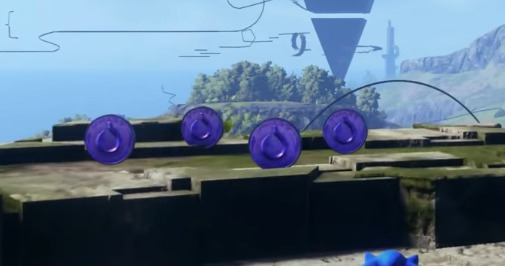
Yet, by the end of the game, I couldn’t help but notice that Big was not with the cast of characters leaving the island.

In fact, we never saw him get sucked into cyber space in the first place. There’s proof that everyone else was seen in the PROCESS of being trapped, except for Big. Eggman went into a forest, did a thing and it immediately backfired before the game had a chance to begin, Tails, Amy and Sonic were all on the Tornado when they got trapped, and Knuckles got his own animated prologue justifying his reason for being here.
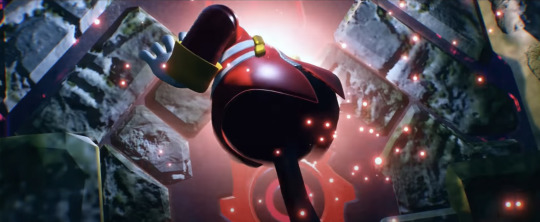
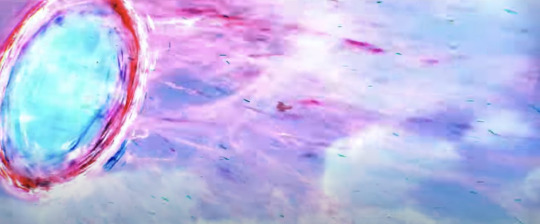
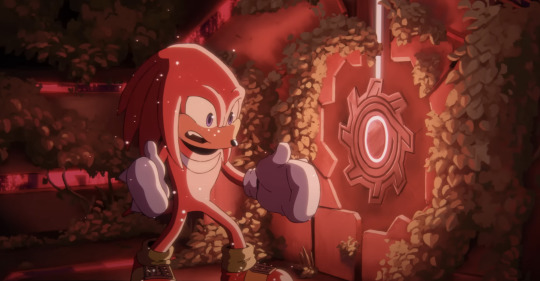
Big, on the other hand, did not. All we get is a line of dialogue claiming he did.
It also became known to us that cyber space is a collection of data pulled from the users’ memories.
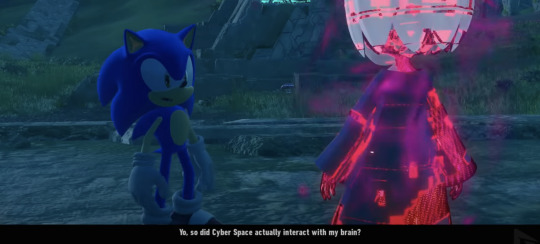



Sonic: “Yo, so did Cyber Space actually interact with my brain?”
Sage: “It was designed to catalogue neural networks, among other things, so yes.”
Sonic: “Alright, hear me out: do you think all those locations I visited were pulled from my memories?”
Sage: “That is plausible. It imported the data of your memories and applied it to your surroundings so you could comprehend them.”
Granted, Sage is technically speaking hypothetically herself, but knowing how Sonic lore works, we have to take this as canon information. Taking this at face value, we have to assume the cyber space we visit as Sonic is pulled from his brain.
Which is why it’s strange that at the end of the game, or DURING the game, Big is never technically mentioned outside of his fishing spaces. It would also explain why things like ring boxes
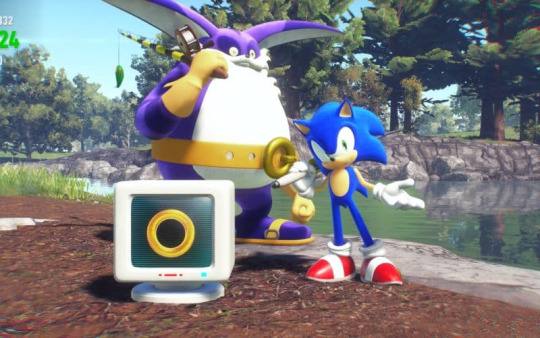
or springs
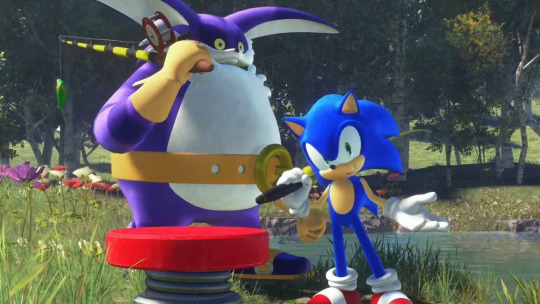
appear in the virtual lake at all. These are from Sonic’s memories!
You could also argue that being the reason why some of the things you catch look... well...

... strange, to say the least.
(Sega’s turning the frogs gay, huh?)
If this is still all in Sonic’s perception, it’d also make sense as to why the blue-ringed octopus or the anglerfish look radically bigger than their real-world counterparts.


Could it just be that Sega didn’t do their aquatic homework? Like they didn’t do their basic research on hedgehogs or on geology/astronomy? I refuse to believe that completely preposterous outlook. Sonic saw a picture of an anglerfish and an octopus, and just like ME at AGE 5, assumed they must be the roughly the size of a bear. (Side note, I’m aware that some anglerfish can grow up to 3 feet, and Sonic’s 3 feet, but this is still an absurd size comparison).
That said, there are still things like the Hermit scrolls that occasionally show up, and Big literally sells you Eggman’s diary memos. One could argue, those things literally couldn’t be in Sonic’s memories. However, cyber space is a communal space. Apparently you can find out information from just about anyone in there.
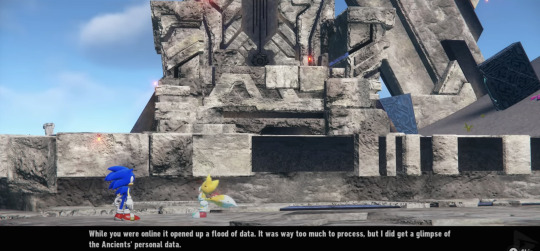
Tails: “While you were online it opened up a flood of data. It was way too much to process, but I did get a glimpse of the Ancients’ personal data.”
Based on this evidence, we can turn to Big, and question his role in Frontiers. He’s a merchant, he’s kind of a punchline, and he provides a break from typical gameplay (also a way to skip obnoxious memory token grinding sessions).
There’s... no reason for him to NOT leave cyber space. His presence in each fishing spot doesn’t suggest he is benefitting from his stay, nor is it assumed that he enjoys his time there. So why doesn’t he leave with them? Big simply tells Sonic that he was looking for fishing spots and ended up in cyber space. However, cyber space recreates itself for Sonic so that he could comprehend it. The Big we spend time with is very likely to be Sonic’s idea of Big, his memory of Big, or cyber space’s excuse to grant Sonic data. It could even be The End/spooky sky voice’s way of forcing Sonic to progress, disguising itself as Big, however my only evidence for that claim is during Sonic’s corruption, Big is not seen anywhere trying to assist Sonic. Even Eggman was there, not helping, but present.


Other than that, that theory is a stretch, even by my standards.
In any case, it was odd to me that Big was totally ignored throughout the game. He’s by no means the most popular character, but if we are to assume it IS the real Big, why would they leave him in cyber space? Why wouldn’t Sonic attempt to free him as well, or at the very least talk about him with other characters?
It may seem like Big is just a wacky character, who just happened to be at the wrong place at the wrong time as usual. But if that was all there is to it, why is this such a... Big... Mystery?
Thank you for reading out my entire existential crisis.
Please have a wonderful rest of your day.
Play Frontiers, it’s fun.
#sonic frontiers#big the cat#sonic frontiers spoilers#theory#don't spoil the comic I haven't been able to read it#yet#if anyone has evidence disproving this theory I'm all ears! I'd love to discuss Sonic with people#even if it's a weird topic to have a conversation over#Again if the comic explains it in depth I haven't read it and I will eventually#It really was keeping me awake at night#this idea that the big we were talking to isnt real#sonic the hedgehog#miles tails prower#amy rose#knuckles the echidna#eggman#analysis#a game theory#rant#long post#sage the ai#prologue
82 notes
·
View notes